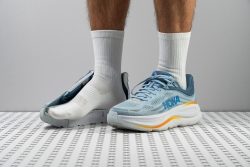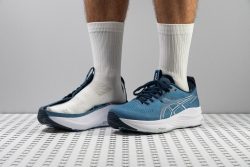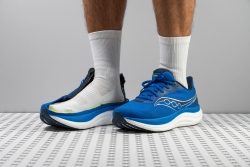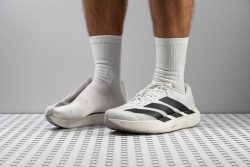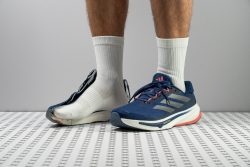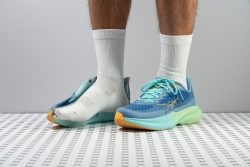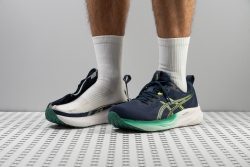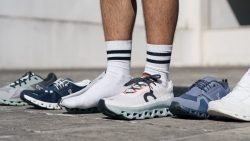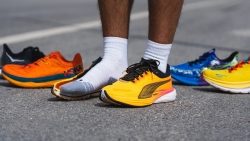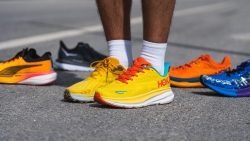7 Best Running Shoes For Shin Splints in 2025
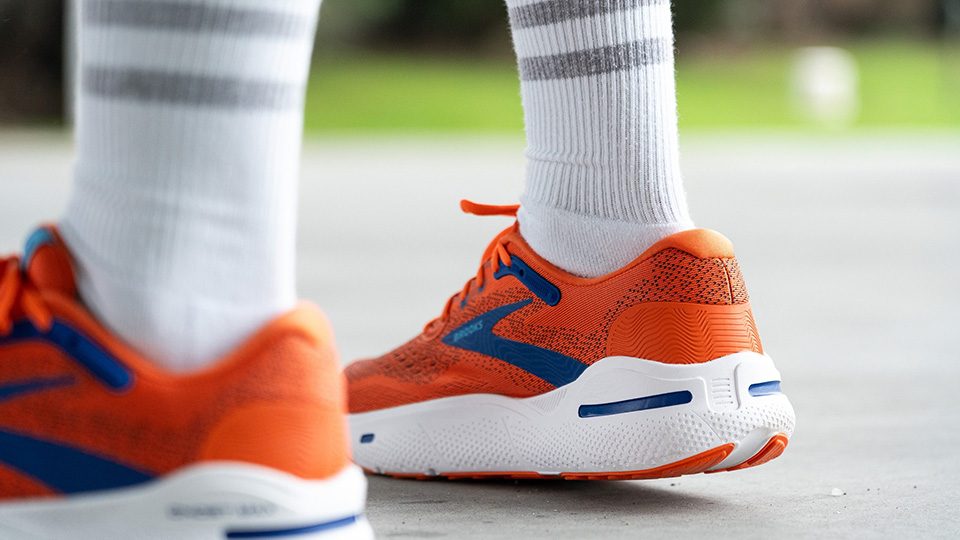
We buy shoes ourselves. We earn commissions when you buy through us, at no extra cost. Why trust us
Shin splints is a very common injury and, therefore, many runners look for the best shoes to wear while dealing with it. Here, we highlight the best picks for shin splints and we base our choices on both lab tests and our test runs.
We also dig deep into which features are needed in the running shoes for shin splints, why, how we measure them in the lab, and how to find running shoes that may help you get through the rehab process.
How we test running shoes for shin splints
We want to avoid being paid to review a certain shoe or getting any kind of incentive for our reviews. Because of this, we buy all the running shoes we test with our own money. We don't get told what to publish. Our reviews reflect our experience with the shoe, both from our runs and from our lab tests.
The objectiveness and transparency of our reviews are reflected in our testing process:
- We buy the shoes on our own
- We run in the shoes and note down everything, from how they fit and feel to how lively and durable they are
- We test the shoes in our independent lab, where we cut them into pieces, freeze them, bend and twist them, and perform dozens of tests to end up with 20+ data points that quantitatively describe each shoe
- We publish all our results on our website. The data is comparable across other shoes from the same category and is always compared to the average, so that our readers can easily understand the full context.
Best running shoes for shin splints overall
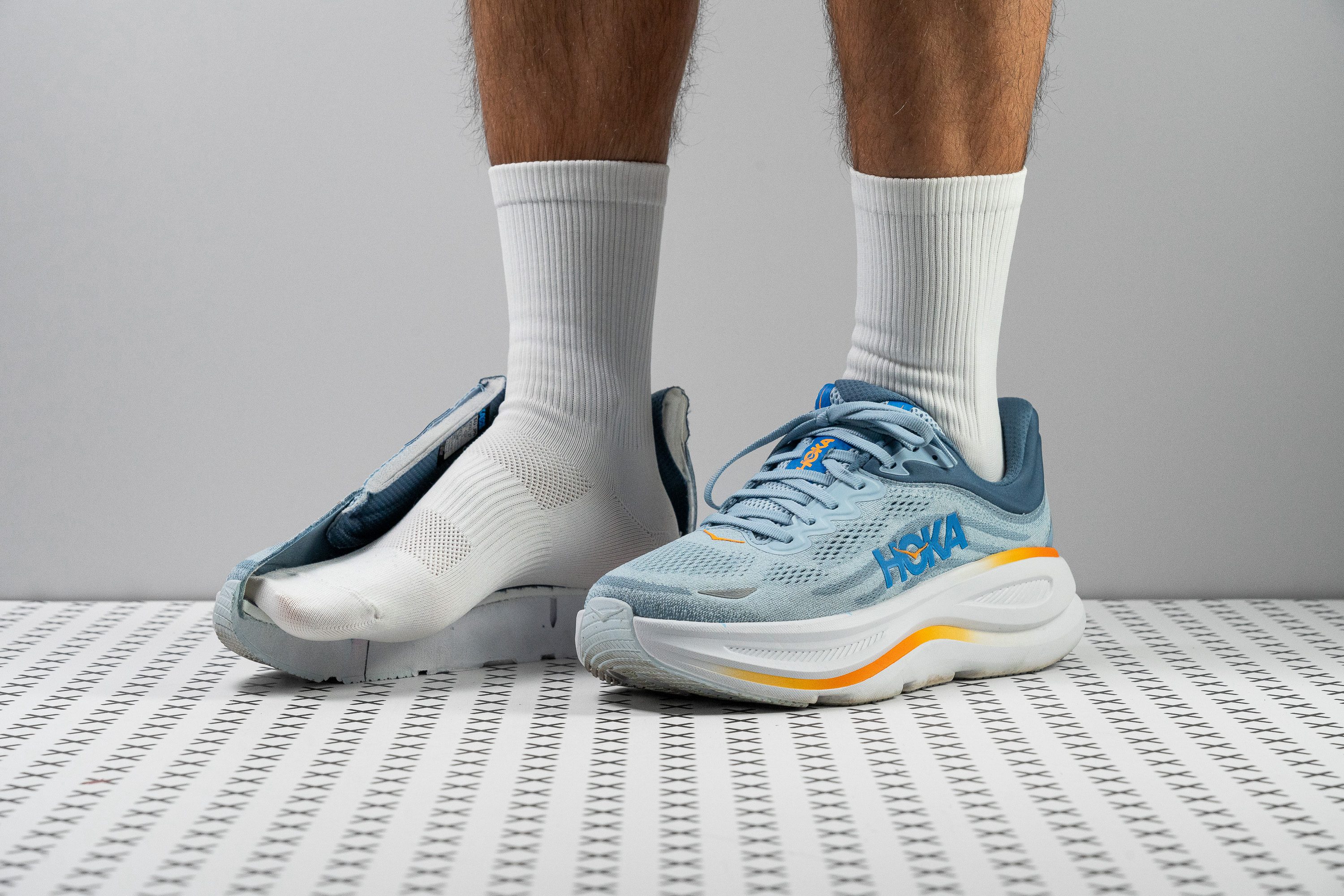



















































What makes it the best?
With its sky-high and impact-absorbing cushioning, the Hoka Bondi 9 takes good care of our feet during our runs. It keeps us confidently surefooted through its broad platform, which we verified in the lab, enhancing support without losing the fluidity needed for comfort. Ultimately, it takes the crown as the best running shoe for those with shin splints.
Our calliper reveals a massive 41.3 mm heel stack, offering exceptional stress reduction as confirmed by its high 146 SA rating in our shock absorption test. Paired with a generous 32.2 mm forefoot, it results in a steep 9.1 mm drop that takes pressure off our ankles, calves, and shins.
The midsole features elevated sidewalls and an expansive base to enhance stable strides. Using our calliper, we verified measurements of 123.2/100.9 mm vs. the 114.3/90.8 mm average. Its high level of torsional rigidity (4/5) also helps keep our foot centred.
Thankfully, Bondi 9’s structure does not come at the expense of smooth and natural movement. In our bend test, it emerged only slightly stiffer than average despite its height, making it comfortable enough for daily wear.
Unfortunately, Bondi 9 won’t impress runners seeking to run fast. Those who prefer a more agile, lightweight trainer should skip this pair.
Pros
- Endless cushioning
- New supercritical EVA midsole
- Amazing step-in comfort
- Doubles as a walking shoe
- Stable for its height
- Built to last
- Excels at slow-and-steady paces
- Well-designed heel collar
- Lighter than v8
Cons
- Not for wide feet
- Still feels heavy and clunky underfoot
- Drop measurement differs from stated
- Non-gusseted tongue
Running shoes for shin splints with the best arch support
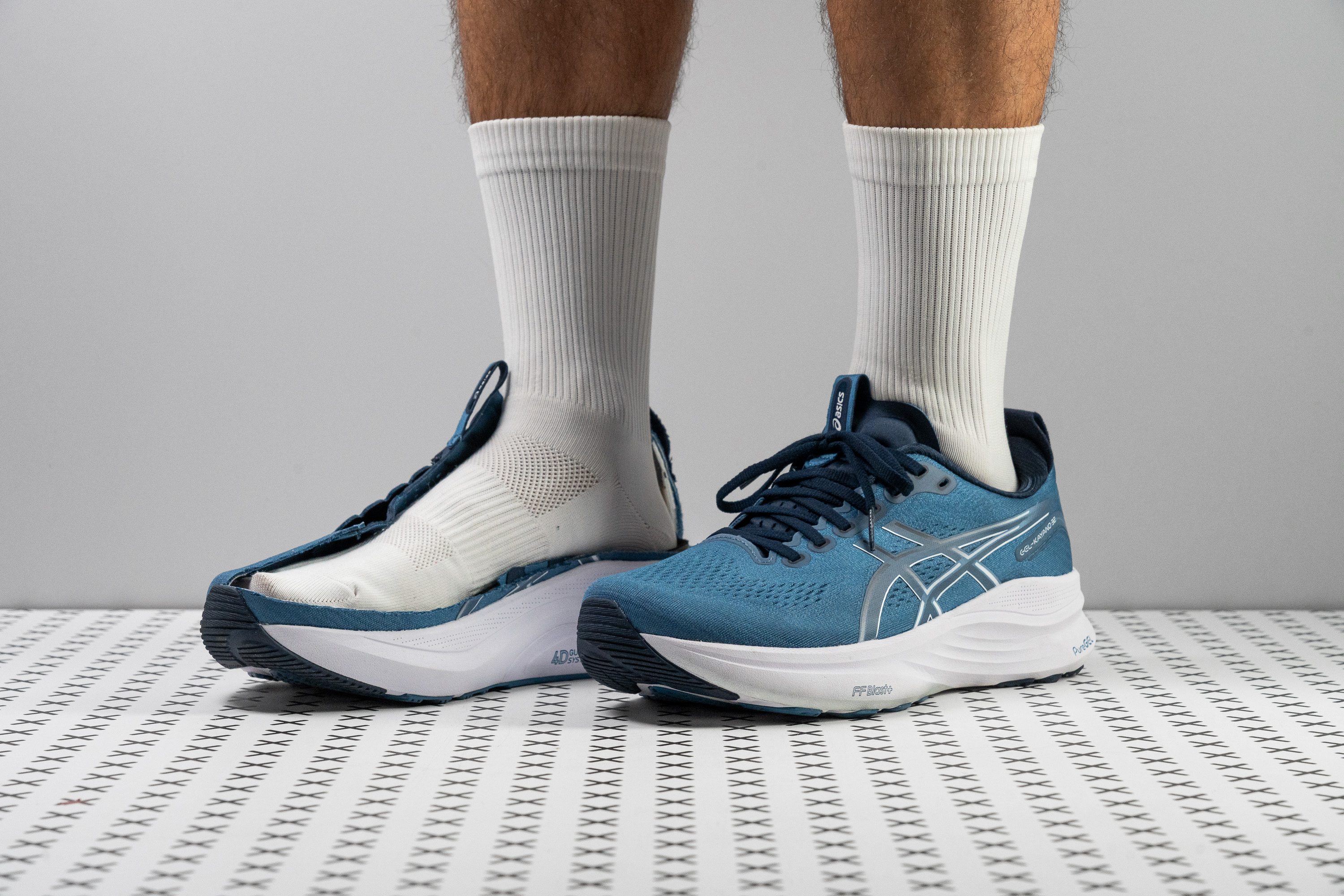













































What makes it the best?
The ASICS Gel Kayano 32 offers both soft and firm support through its 4D Guidance System and cushioned midsole. Each landing feels stable, with limited lateral movement thanks to the wide base, and also gentle because of GK32’s high shock absorption, which we verified in the lab. Among shin splint running shoes, it delivers unmatched arch support.
As our arch collapses, the 4D Guidance System in the midfoot helps keep us centred. It limits excessive movement, which may cause more pain and even injuries. We tried to twist the midsole with our hands, and it didn’t budge, so we rated it with the maximum 5/5 torsional rigidity score.
Besides the midsole sidewalls, the broad landing platform enhances a well-planted feeling. Our calliper reveals it’s 119.8 mm in the forefoot and 97.2 mm in the heel, making it as stable as a table.
Underfoot, we enjoyed abundant cushioning: 39.9/30.6 mm to be exact! Together with the PureGEL insert in the rear, our muscles feel well-protected, evidenced by GK32’s high 133 SA rating in our shock absorption test. The comfortable stack significantly reduces pressure on our calves and shins.
However, we wished the outsole could have been slimmer to reduce the shoe’s overall weight. Runners who still find 10.4 oz (295g) a burden on foot should go for lighter options.
Pros
- Amazing shock absorption
- Plush and breathable upper
- Made to last
- Dependable for most pronators
- Heavy-duty outsole with excellent grip
- Stable as a table
- Pillow-soft heel padding
- Improved fit
- Excellent build quality
Cons
- Not for soft-foam lovers
- Bad energy return
- Overpriced in Europe
Running shoes for shin splints with the best shock absorption
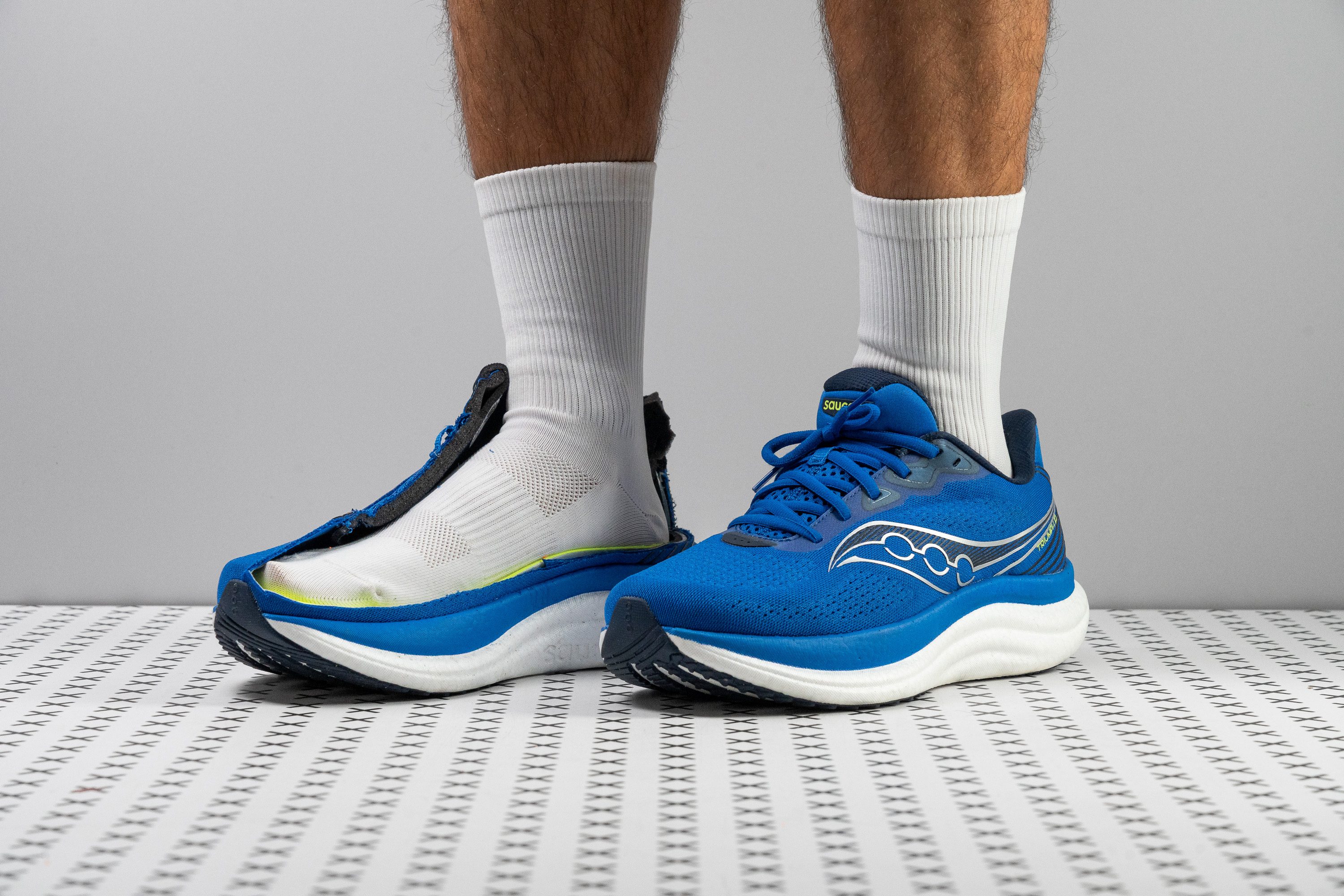












































What makes it the best?
The Saucony Triumph 23 can take the beating of countless strides, with its exceptional midsole reducing stress on our muscles. Backed up by lab tests, it’s our shin splints running shoe with the best shock absorption. Besides comfort, it offers undeniable support while keeping its weight low.
Any type of foot striker and even heavier runners will benefit from the Triumph 23. We tested for its shock absorption in the lab and received elite scores of 149/136 SA in the heel and forefoot, offering 15.5% and 28.3% better impact protection than average, respectively. We had no instances of straining our shins even during the latter miles of our runs.
We also had no instances of losing our balance, since the platform runs wider than average. Our calliper confirms a 124.0/98.9 mm reading, with both measurements being significantly wider than the 114.3/90.8 mm average.
Amazingly, all the comfort and support is packed in a light 9.6 oz (272g) package. A maximalist achieving a sub-10-oz figure is amazing!
What underwhelmed us in the lab was its airflow. We recommend going for a more breathable shoe, especially in long-distance or warm-weather running.
Pros
- Amazing energy return
- Lighter than previous version
- Huge cushioning for long runs
- Wide platform makes it really stable
- Full PWRRUN PB midsole
- Premium sockliner
- Durable build overall
- Versatile enough for daily wear
- Consistent performance in cold temps
- Excellent grip
Cons
- Price increase
- Ventilation could be improved
- PWRRUN PB may feel firm to some
- Bulkier build limits agility
Running shoes for shin splints with the best energy return
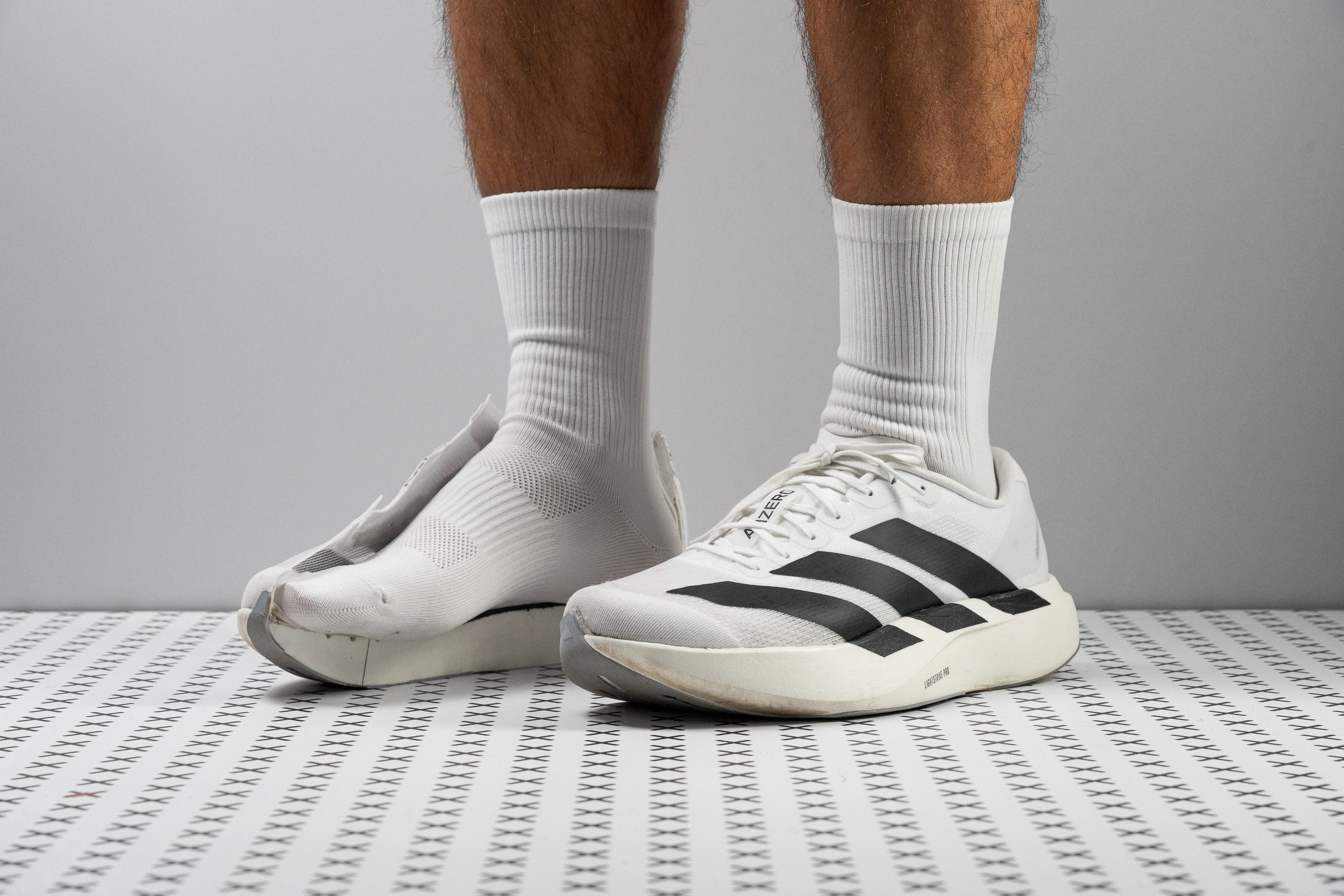


































































What makes it the best?
After our runs, we believe those seeking a fun and dynamic ride without losing comfort and versatility will truly enjoy the Adidas Adizero EVO SL. After all, lab results show it offers the best energy return among shin splint running shoes, without aggravating any pain and injuries through its protective cushioning and light build.
The Adizero EVO SL is full of life, and our energy return test results mirror what we experienced. Reaching 74.3% in the heel and 70.3% in the forefoot, both figures exceed the lab averages. What’s amazing is how it offers responsiveness without needing a carbon plate.
The impact-absorbing midsole was a joy to run with. Its 36.1/28.1 mm stack height reduces ground feel, while its shock-absorbing foam takes care of our joints and muscles. Our lab results show a high score of 147 SA in the heel and 126 SA in the forefoot.
The shoe feels effortless on foot with its superior combination of lightness and flexibility. Our scales show it’s only 7.9 oz (223g), making it 15.8% below average. Its pliability enhances its versatility, as it emerged 35.5% more bendable than average.
However, runners needing extra support may feel unstable in this shoe’s narrow midsole. This speedster demands neutral form.
Pros
- 100% Lightstrike Pro superfoam
- Exceptional value-to-performance ratio
- Low weight
- Ultra-breathable upper
- Unmatched versatility
- Agile and fun ride
- Handles short and long runs with ease
- Striking Evo 1-inspired aesthetics
- Striking Evo 1-inspired aesthetics
Cons
- Poor-quality laces
- Short, non-gusseted tongue
- Toebox durability
Best running shoes for shin splints and wide feet
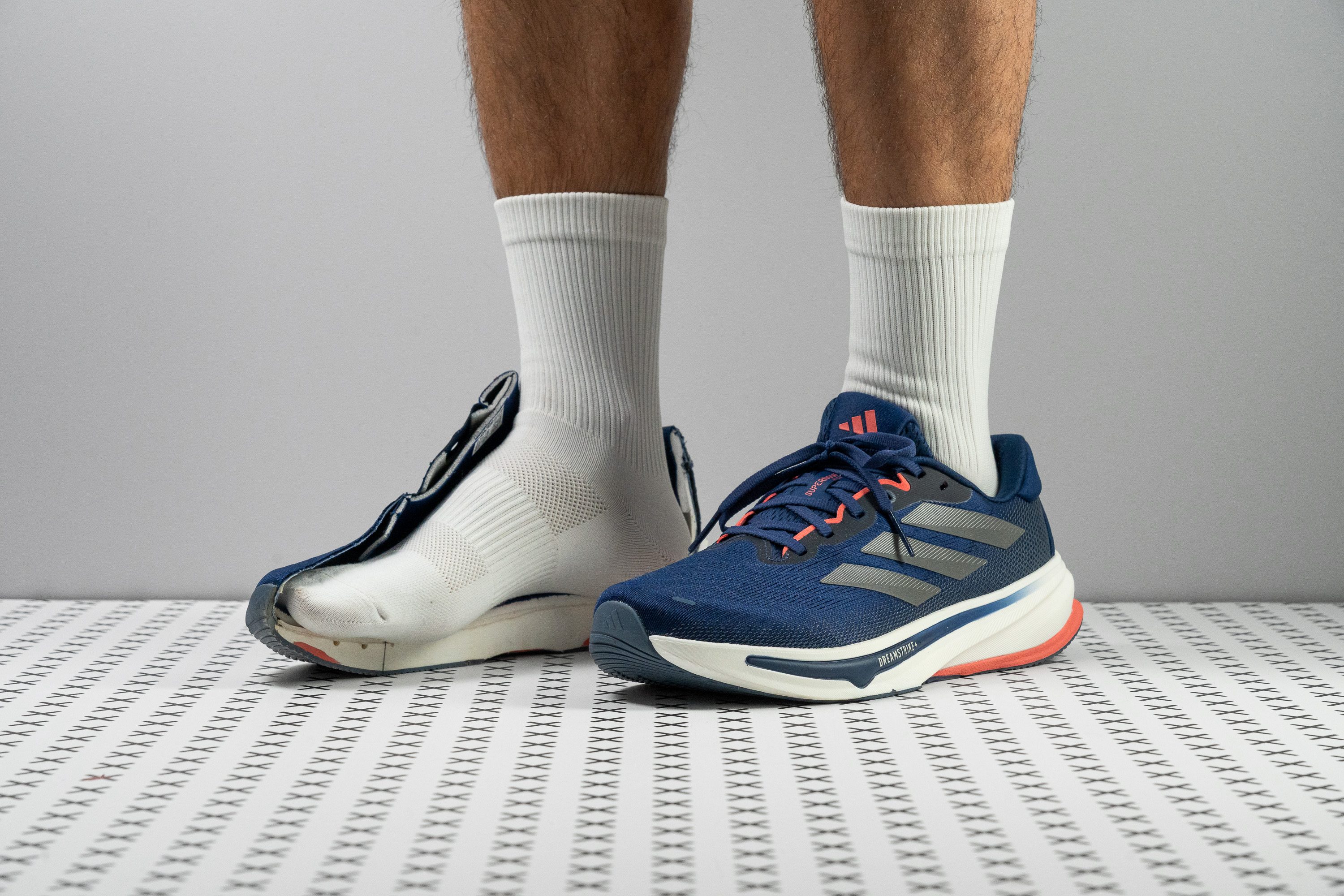

















































What makes it the best?
The Adidas Supernova Rise 2 feels utterly spacious, comfortable, and stable, which is why it’s our top pick for wide-footed folks dealing with shin splints. Lab results show generous dimensions at its width, enhancing a well-planted footing and a forgiving fit. Plus, its ergonomic stack and lightweight build eliminate any chance of additional strain on our muscles.
We immediately measured the shoe’s width to verify its roomy fit, and recorded an impressive 98.7 mm, making it more accommodating than the 95.1 mm average. Even those of us with broad feet experienced no pressure points and felt at home throughout the entire testing process.
Its stack features a steep 9.5 mm drop, reducing the strain on our calves and shins. When we wanted to extend our mileage, we could do so easily since the midsole feels less taxing on our muscles, especially since the shoe is light at 9.1 oz (257g).
The stiff base, along with the Support Rods, feels very supportive. Its sidewalls embrace the heel, ensuring a centred ride, confirmed by its high 4/5 heel counter stiffness in our assessment.
Unfortunately, the heel runs narrower than average. Rear strikers who need more space in this area for planted landings should try other options.
Pros
- Lighter than version 1
- Comfortable yet breathable upper
- Cold-proof PEBA midsole
- Stable ride with Support Rods
- Reflective accents for night visibility
- Maintains competitive price tag
- Responsive Dreamstrike+ foam
- Flexible, natural running experience
- Great for walking
Cons
- Outsole lacks Continental
- Not cushioned for forefoot strikers
- Still lacks a gusseted tongue
Best lightweight running shoes for shin splints
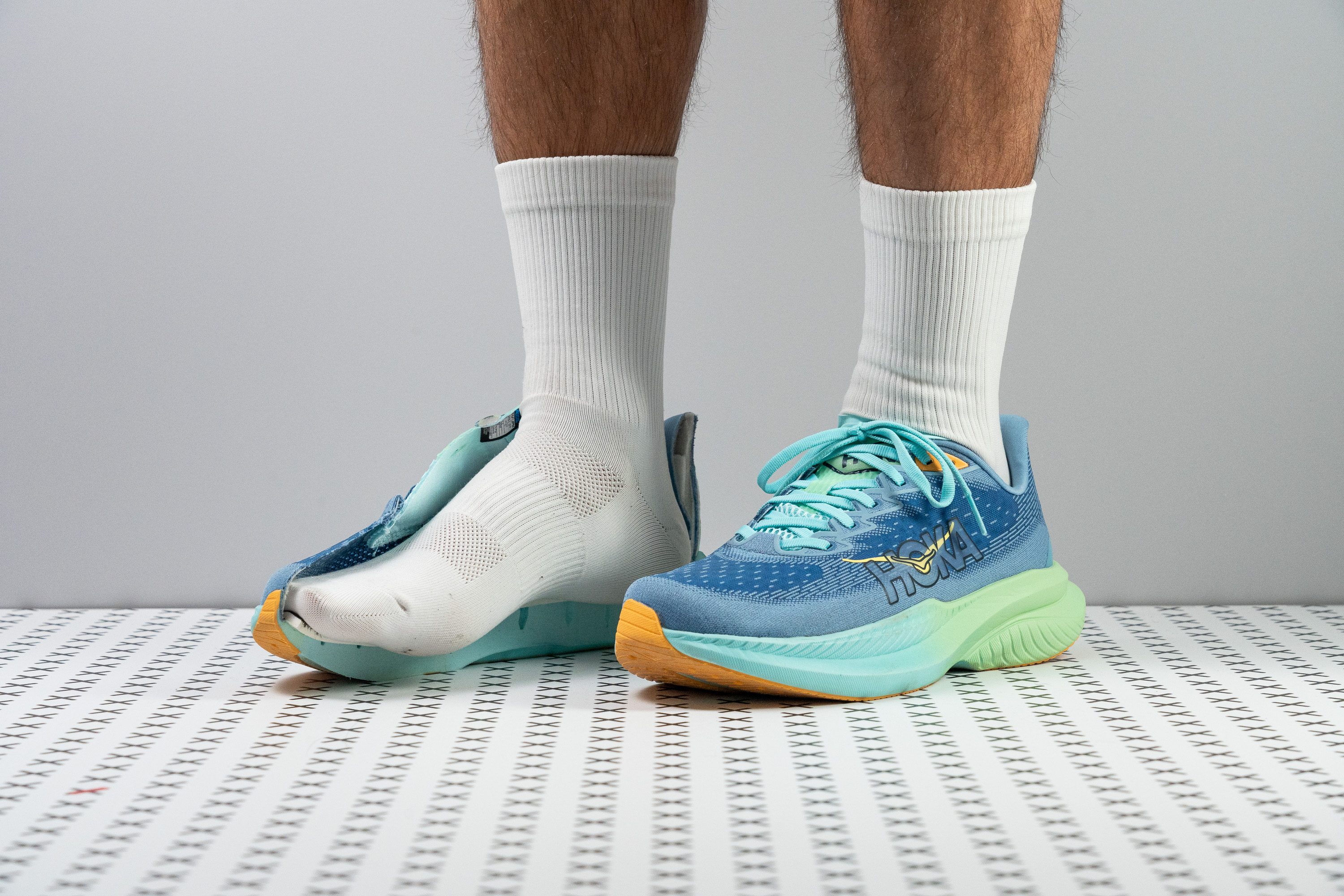























































What makes it the best?
The Hoka Mach 6 offers the cushioning and support needed for those dealing with shin splints through its impact protection and supportive platform, which we measured in the lab. And it does so in its minimal package, making it our best lightweight shin splints running shoe!
This trainer moves as one with our feet, courtesy of its light and loose build. Our scales show it’s only 8.2 oz (232g), making it 12.5% below the average. Moreover, its weightlessness is enhanced through its pliable midsole, emerging 9.9% more flexible than average.
With 36.0/26.4 mm of foam beneath our feet, Mach 6 can handle long runs with ease. It offers impressive shock absorption of 135/114 SA, which effectively relieves our muscles. Plus, its steep 9.6 mm drop takes the load off our lower leg muscles and prevents aggravating our shins.
We felt sure-footed throughout the miles in the Mach 6. It has a twist-resistant midsole that guides our foot alignment effectively, proven by its 4/5 torsional rigidity score in our manual assessment.
Unfortunately, its limited toebox width may be a dealbreaker for some. We recommend those with wide feet to find a more accommodating trainer.
Pros
- Really lightweight
- Fantastic outsole
- Exciting ride
- Highly cushioned
- Great for heel strikers
- Handles faster paces
- Superb lockdown
- Excellent value at $140
Cons
- Drop varies from stated
- Tapered toebox
- Thin tongue
Best budget running shoes for shin splints













































What makes it the best?
The ASICS Gel Pulse 16 brought comfort and support in a lightweight package. And it does so with an accessible £100 price, making it our best budget shin splints running shoe! For reference, the average daily trainer costs £130.
What’s hard to miss is the cushioning’s protective ride, reaching a stack height of 36.5/26.3 mm. The steep 10.2 mm drop lets the hips and knees take over, so the shins don’t have to. We measured shock absorption scores of 127 SA in the heel and 101 SA in the forefoot, relieving our muscles during daily mileage.
To ensure we prevent stressing the shins further, the Gel Pulse 16 offers a steady and secure ride through its wide and rigid base. We measured it at 119.3/97.8 mm, exceeding the average midsole by a mile. Moreover, the shoe barely twisted in our manual assessment, so we gave it a high 4/5 torsional rigidity score.
With all these features, its minimal 8.5 oz (241g) is exceptional. Being 8.7% lighter than average, it keeps our movements and transitions seamless.
However, runners who sweat a lot and need ventilation will struggle to finish heated workouts in this airtight shoe. If breathability is a must, we can’t recommend this trainer.
Pros
- Very stable ride
- Surprisingly lightweight
- Durable and grippy outsole
- Good cushioning
- Upper features recycled materials
- Excellent value for money
- Beginner-friendly
Cons
- Upper needs improvements
- Very low energy return
- Tapered toebox
While it seems easy to diagnose, this injury, like any other, can get worse. We always recommend seeing a specialist for a proper diagnosis and rehab plan. In this guide, we give no medical advice. Also, the pain can persist or worsen, which might lead to a stress fracture. Better to prevent this!
Shin splints and running
Shin splints, also known as medial tibial stress syndrome or MTSS, are a common overuse injury in runners, causing pain along the inner edge of the shinbone (tibia). The repetitive stress (overuse) inflames the muscles and tendons around the shin bone which results in pain.
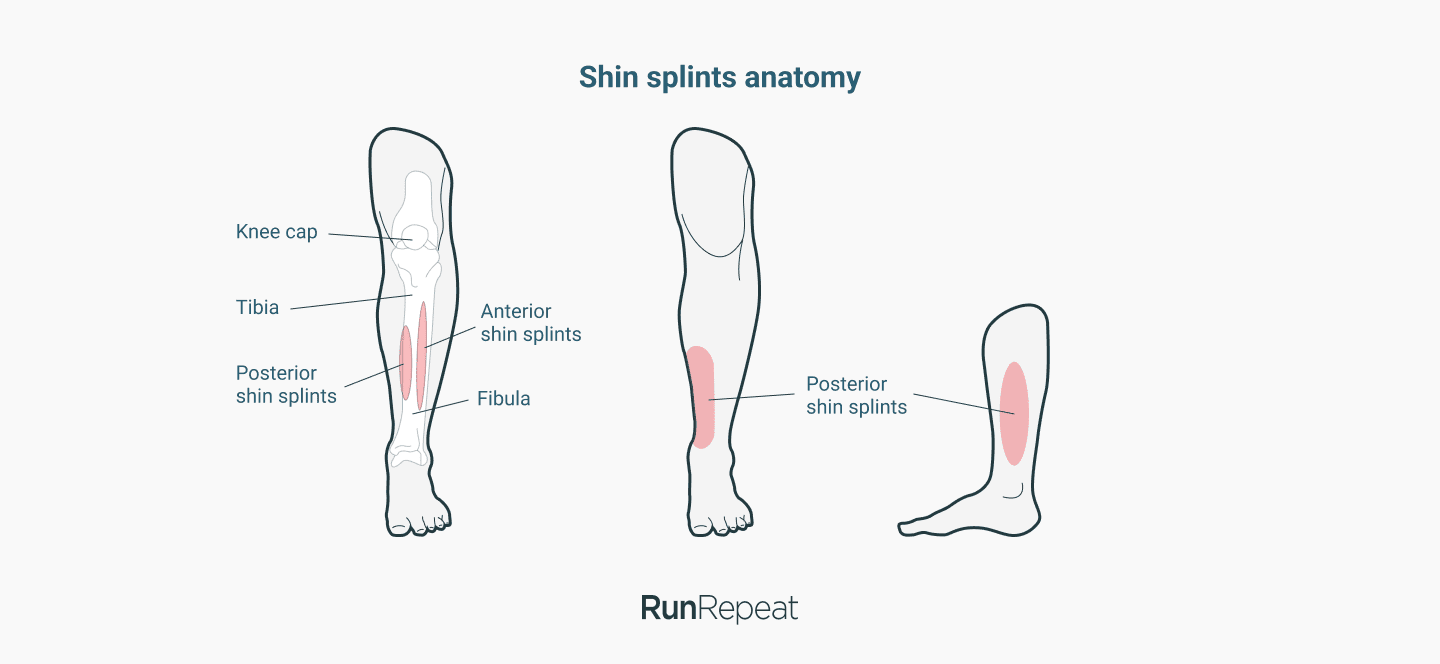
In most cases, overtraining is the cause of shin splints. However, other factors can also contribute, such as a BMI over 30, bad choice of footwear, or ankle/foot muscle imbalances.
This is the third most common injury in runners, with women being affected more often than men.
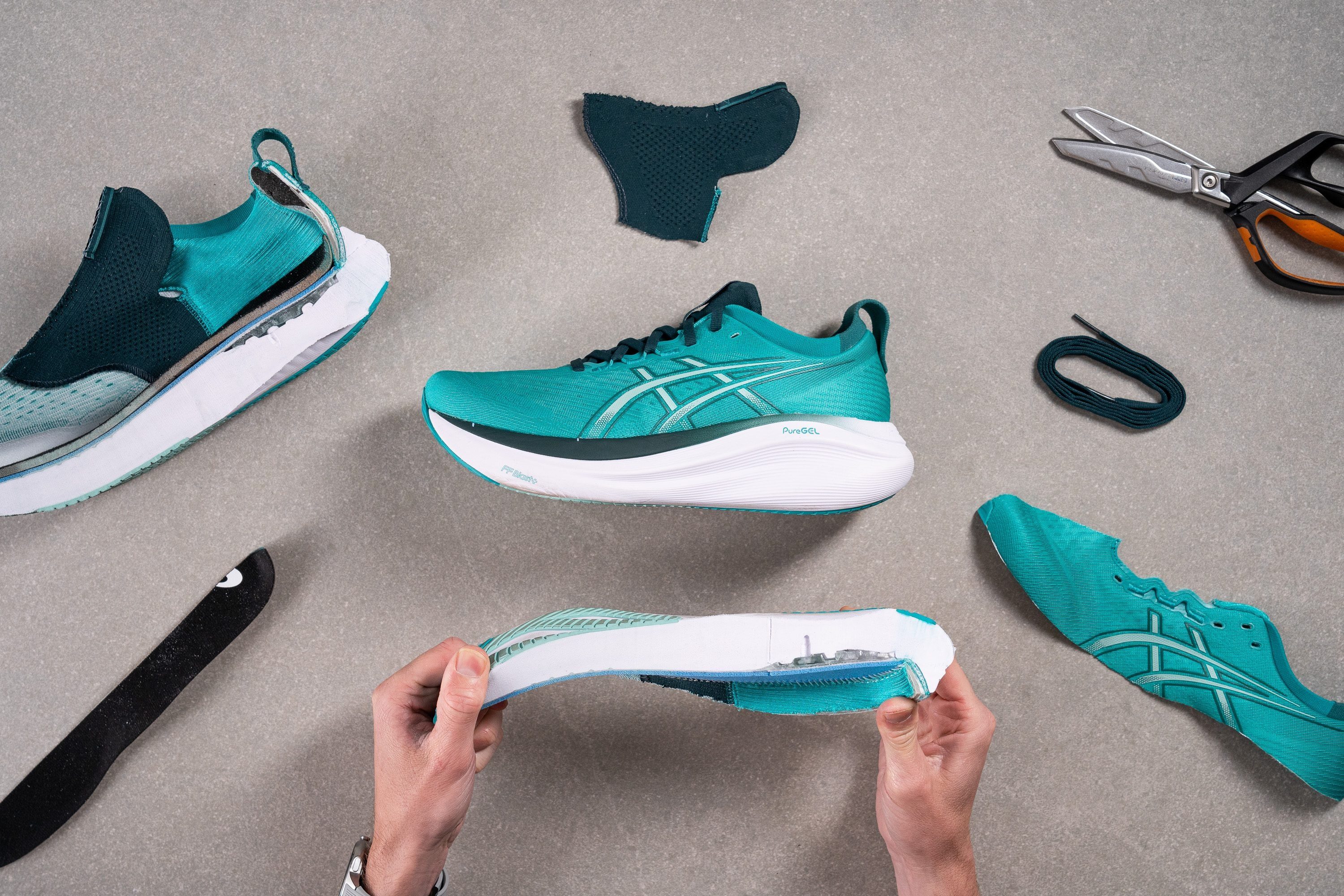
4 features to look for in running shoes for shin splints
Given that shin splints are an overtraining injury, we found that a combination of support and stability works best when taking things slower. These are the features that reflect that stability and support:
- Cushioned running shoes with at least 35 mm of stack height at the heel
- Running shoes that are somewhat torsionally rigid. These shoes score 3, 4, or 5/5 on our torsional flexibility test. They can’t be twisted easily!
- Platforms that are wider than 90 mm at the heel. We want planted landings!
- Daily running shoes without carbon-fibre plates. Taking it slower and easier means not doing tempo runs or races, so daily trainers are your best option as they won’t nudge you toward faster paces.
Below, we’ll cover all of these shin-splints-friendly features in greater detail.
Look for high-stacked shoes when dealing with shin splints
The idea here is to make sure less stress is sent toward the lower-leg extremities. One way of doing this is running in cushioned running shoes. We recommend those with at least 35 mm at the heel. Such running shoes offer a lot of impact protection, which is great for shin splints.
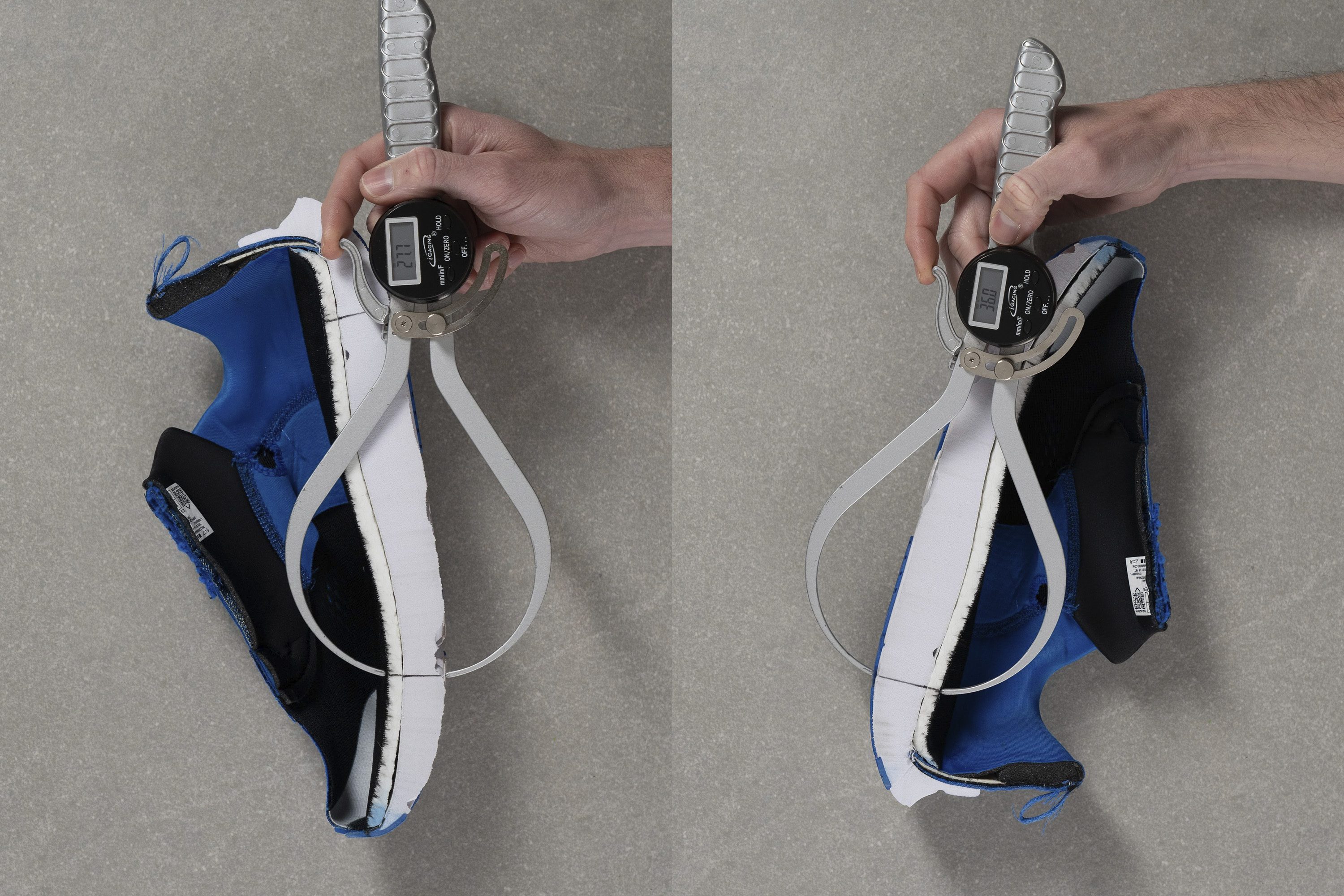
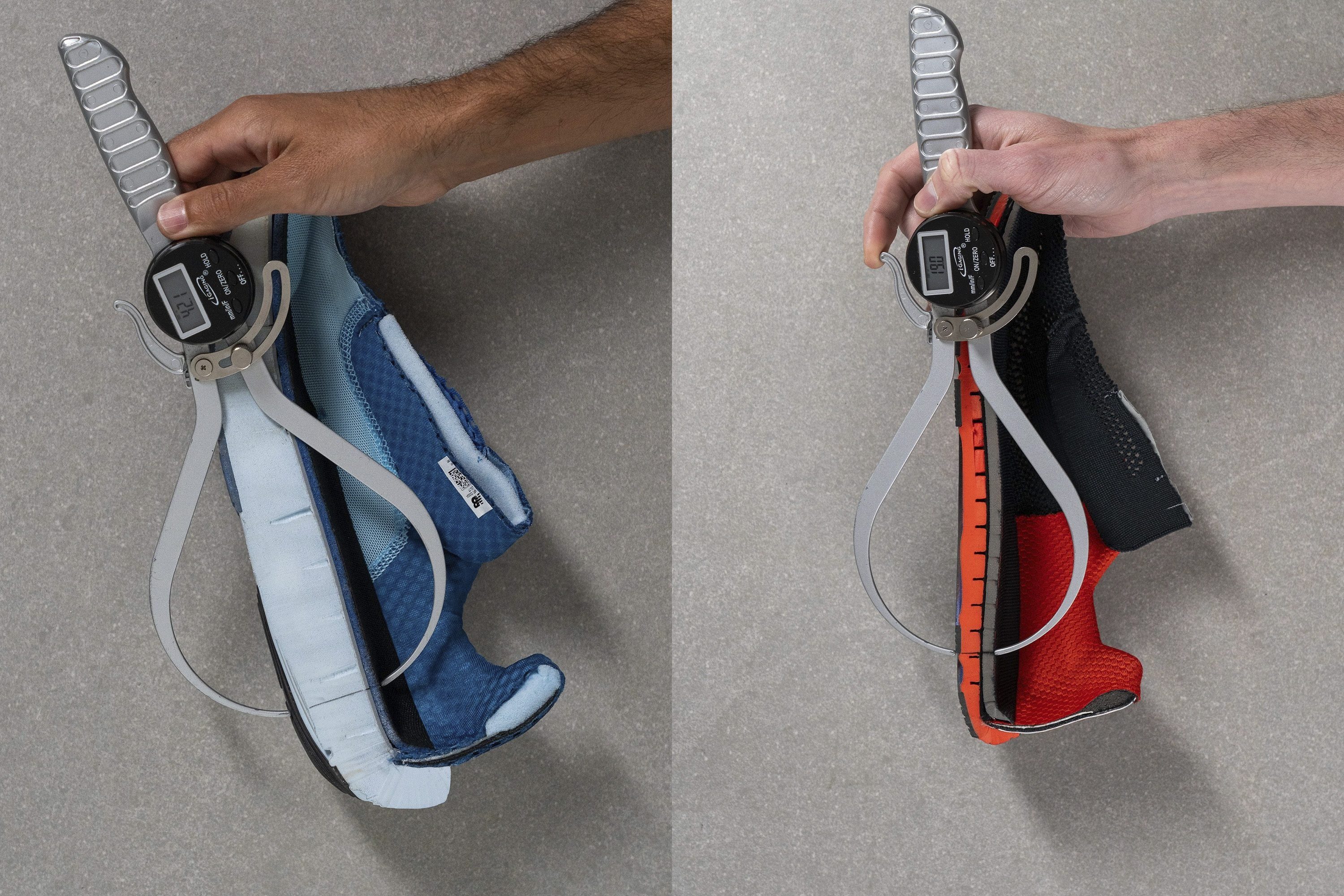
The good thing here is that there’s a lot of “wiggle room” when it comes to softness.
You may look for a firmer or a softer platform, depending on what feels good and what does not irritate your shin muscles.
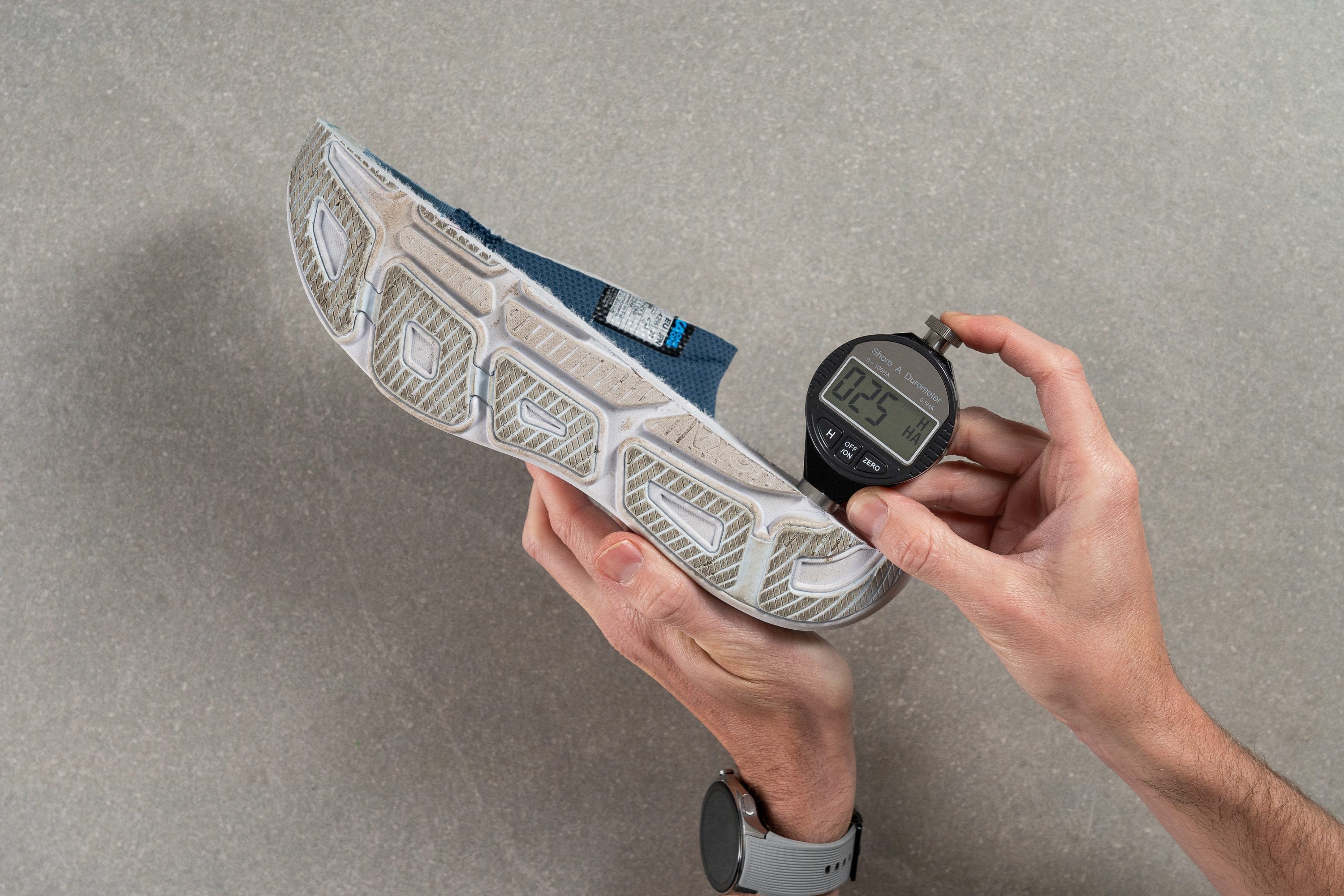
How can heel drop help when you have shin splints
When discussing cushioning, we mentioned only heel stack height (minimum 35 mm). What about the forefoot stack height? This difference between the 2 stack heights is called heel-to-toe drop. The drop varies from 0 mm to roughly 16 mm.
And the most significant effect of heel drop on runners’ legs is the way it changes which muscles are utilised: the higher the drop, the greater the stress sent to the higher leg muscles. In running shoes with a low drop, lower-leg muscles are utilised. Following this logic, zero-drop running shoes make runners use foot muscles the most.
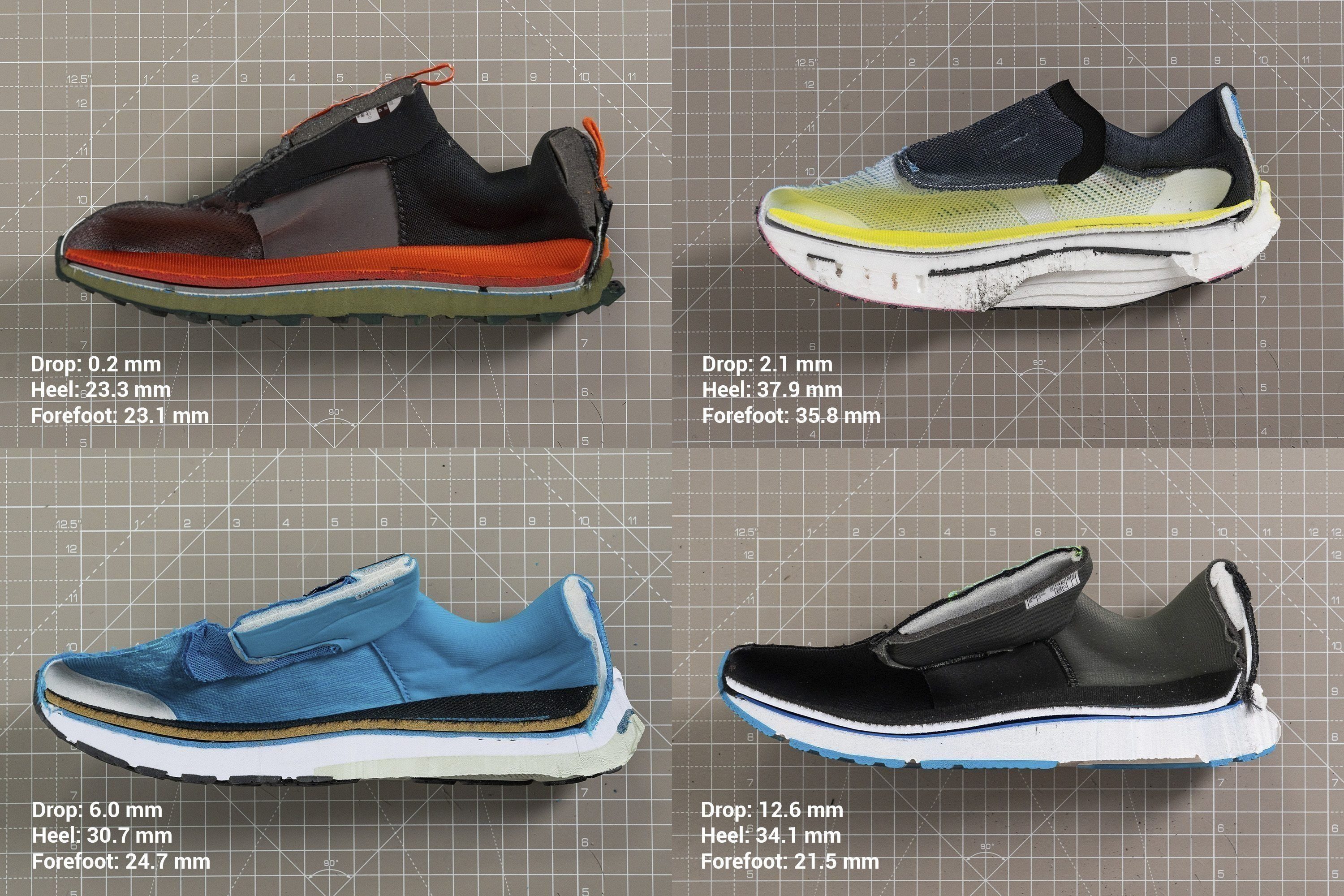
This means that you may experience less strain on the calves and shins in running shoes with a higher heel drop (5mm and higher) and see if that works for you. On the other hand, runners sometimes gradually transition to lower-drop running shoes because this strengthens the calves, Achilles, and foot muscles.
Dead midsoles are bad for shin splints
The longevity of the midsole is not something that is easily measured or quantified. It depends on the quality of the foam, how old the shoe is, the weight of the runner, their foot strike and pronation, and other factors.
|
Runners usually start experiencing premature fatigue when foams are dead. However, an injury or strain can creep in without you noticing that the midsole is done. It makes sense to pay special attention to the midsoles after 300 miles. The difference between the new and old shoes (the same model) can be significant! |
Here, we can talk about the types of foams though. There are 2 large groups of foams found in running shoe midsoles: standard foams and premium foams. And the differences are wild.
|
Standard foams |
Premium foams |
|
Usually found in daily trainers |
Usually found in race shoes |
|
More durable |
Less durable |
|
Affordable |
Expensive |
|
Not so bouncy |
High energy return |
In this regard, you can rely on standard foams to be more durable. Fortunately, most daily trainers feature standard and not premium foams. The difference, next to the energy return that you can experience only once you’ve tried them on, is in the price tag.
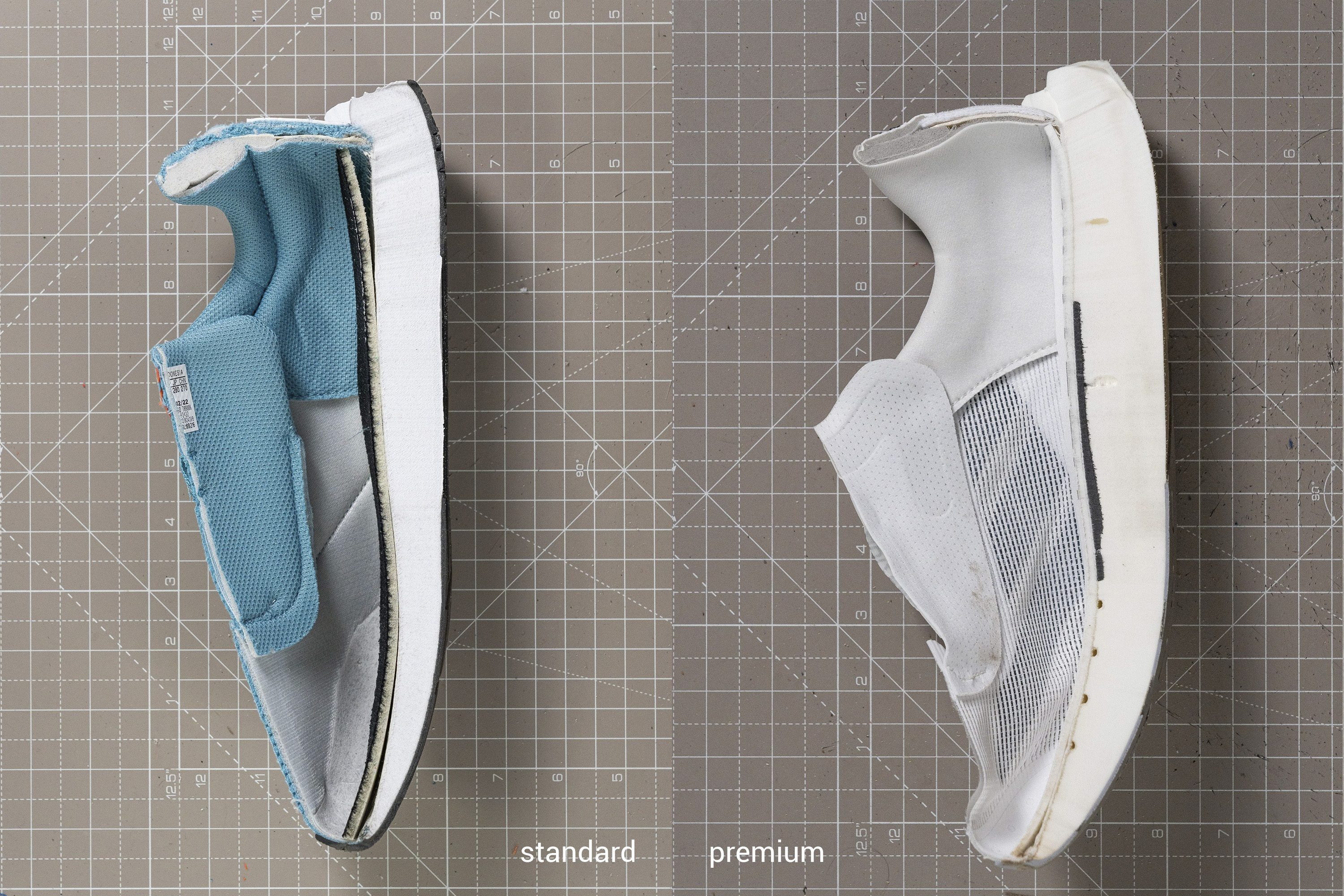
If you’re wondering about the foam used in your shoe, we recommend finding it in our extremely detailed guide on running shoe foams and learning about its features.
Find running shoes with a rigid platform
The idea is not to run in shoes that are too flexible. When the running shoe’s platform can be twisted easily, our feet and lower-leg muscles need to work more. Even if it’s micromovements, when it comes to the overuse injury, we’d rather avoid that.
We recommend finding shoes that scored 3, 4, or 5/5 on our torsional rigidity test.
There’s a lot of confusion between torsional and longitudinal stiffness, so we’re here to clear that up as well. Torsional: twisting the shoe, longitudinal: bending the shoe.
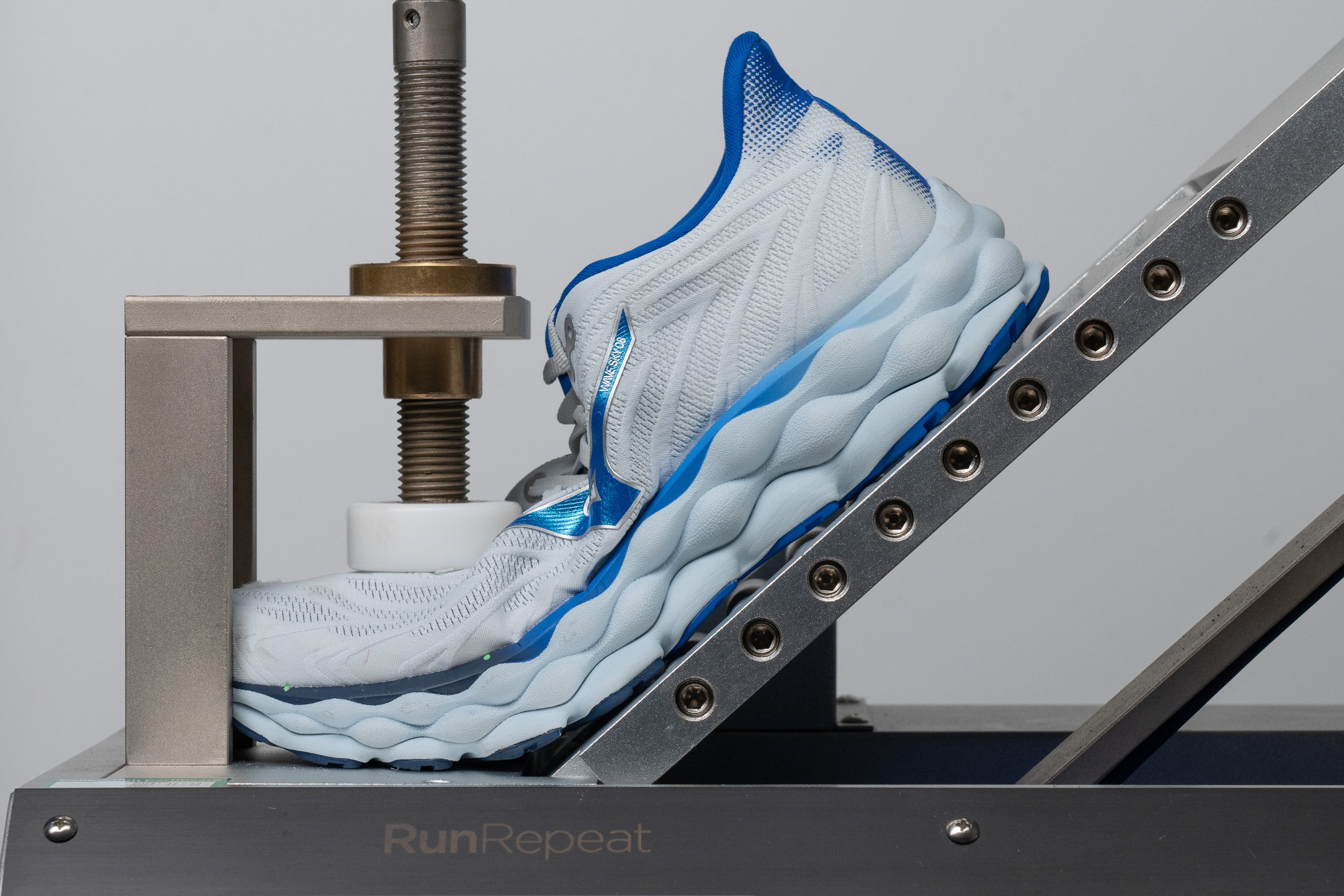
To measure the longitudinal stiffness, we use a stiffness-testing machine to bend the shoe to 30 degrees after locking the toebox in place and adjusting the position of the bottom plate for the forefoot rocker. The force needed to bend the shoe tells us how stiff a shoe is; the lower the force, the more flexible the shoe!
Fortunately, running shoes that are more torsionally rigid can also be quite flexible, for those worrying about the natural feel that comes only with running shoes that are flexible.
Stable ride matters when dealing with shin splints
And this stability comes from wider midsoles (among other things like a rigid platform, firmer midsoles, stiffer heel counters, etc.). The wider the platform, the more stable the ride. That’s why race shoes often feel unstable at cornering or even on slightly uneven terrain - they are high-stacked and narrow!
IMAGE race platform narrow vs wide daily trainer
The difference in platform width between a competition shoe (left) and a daily trainer (right)
The great thing is we measure the width in our lab.
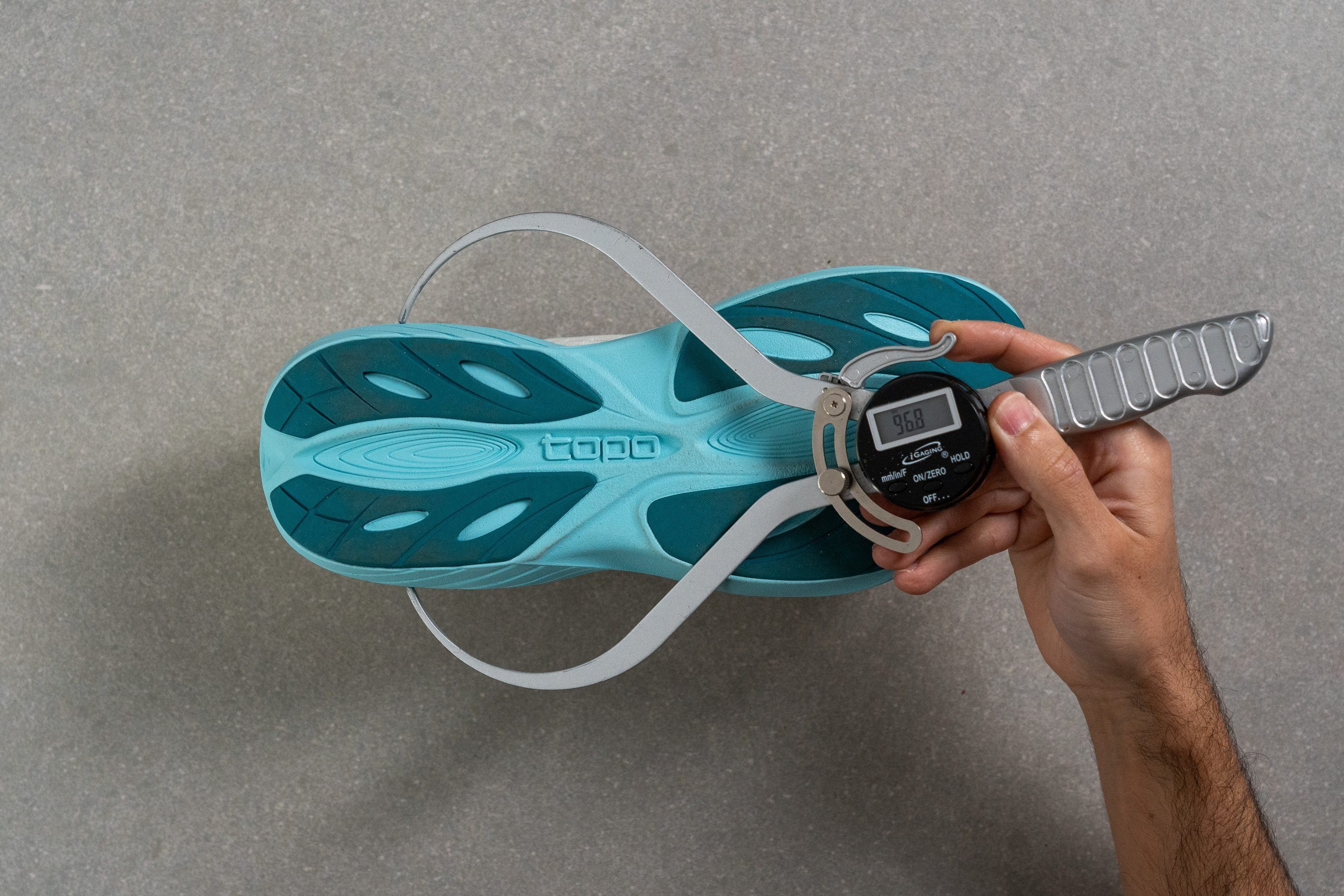
Knowing these numbers allows us to sort running shoes for shin splints by the width at the heel for those who want to feel extra stable.
Daily trainers with no carbon plates
We recommend running in daily trainers because the idea is to slow down, rest more, and exercise active recovery. Running in tempo shoes or race shoes will not do that but make you run faster.
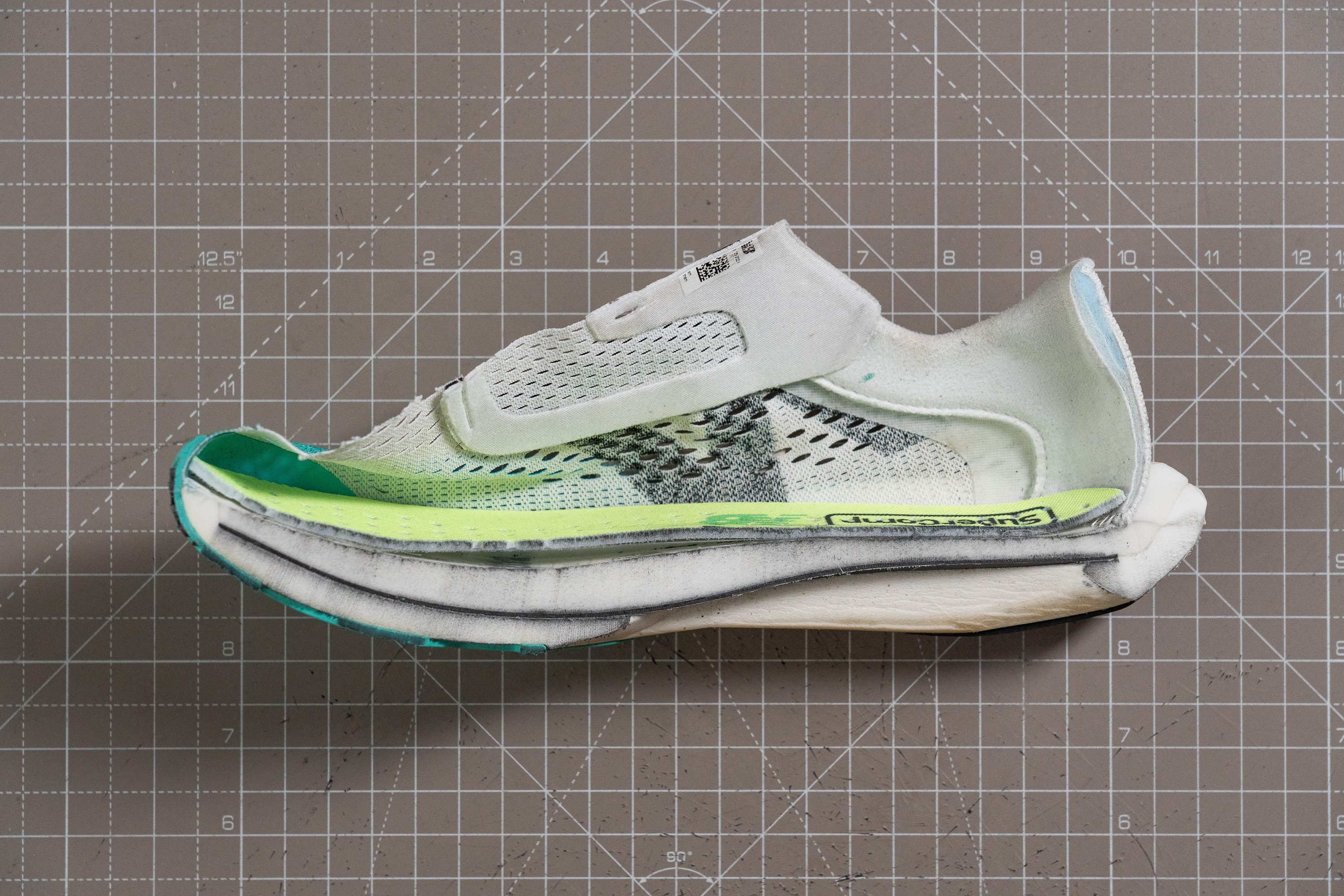
We recommend running in daily trainers that are not plated because carbon-fibre plates work best when combined with premium foams. This makes the shoes less durable and more expensive, which is not ideal when dealing with shin splints. Also, running shoes with carbon-fibre plates are often activated at faster paces, while forefoot striking, both of which are not ideal for shin splints. We covered all of this and much more in our guide on plated running shoes.
Breathability of running shoes for shin splints
Setting stability and support aside, weather matters. No one loves frozen toes or soaked socks. Here’s how we deal with this. We pump the smoke into the toebox and watch where the smoke comes out and how quickly. Based on this, we assign a breathability score on a 1-5 scale, where 5 is the most breathable.
Digging deeper, we also look at the uppers under the microscope.
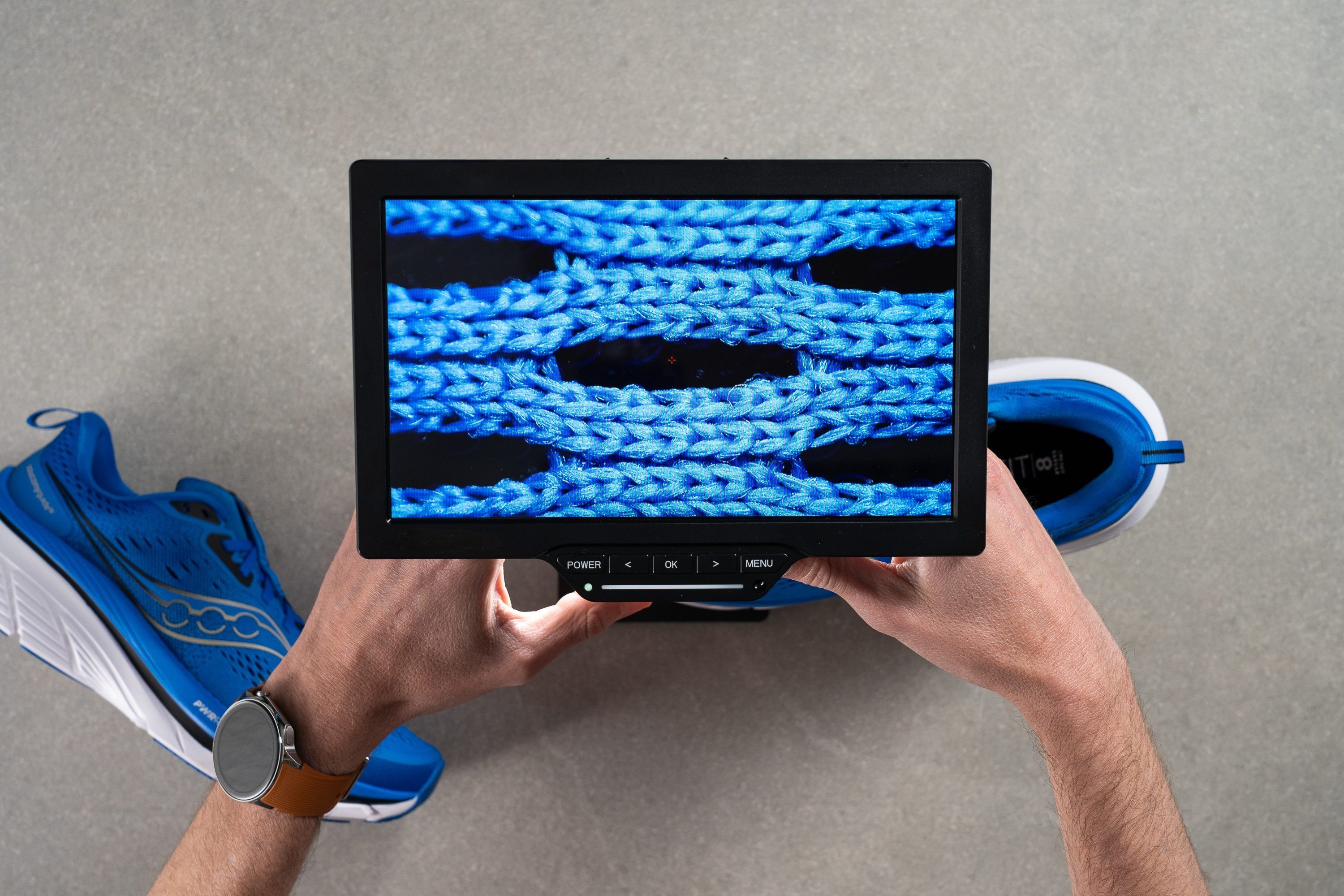
This allows us to understand what’s happening: are there a lot of small ventilation holes? Are there more layers intertwined? Is the structure packed tightly so not even air escapes?
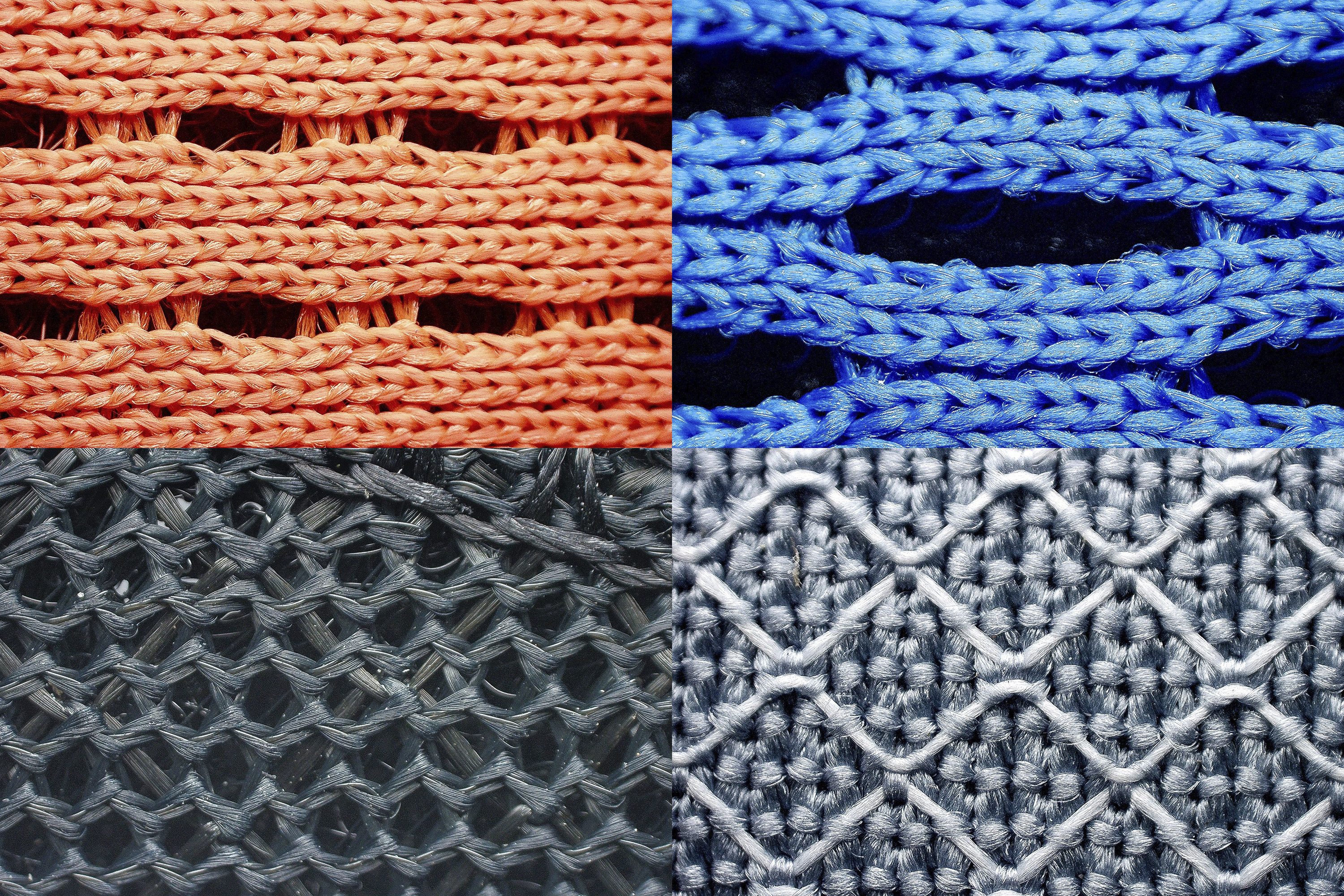
We recommend running shoes that scored 4/5 or 5/5 on our breathability test if you a) plan to run in hot weather, or b) have sweaty feet. If you live in a cold climate, we recommend running shoes that trap heat - those that scored 1/5 or 2/5.
How durable are running shoes for shin splints
We’ve covered the durability of the midsole above and here, we’ll show the durability of 3 parts of the shoe that we can actually quantify in our lab. We always use a dremel to damage the shoe and we do it in a controlled environment. Our tests are standardised, meaning we always apply the same force, same RPMs, and the duration of the test, as our videos show.
When testing the durability of the toebox, we damage the upper and then quantify the durability on a 1-5 scale. 1/5 is the least durable (the largest and/or the deepest holes) and 5/5 is the most durable (barely any damage).
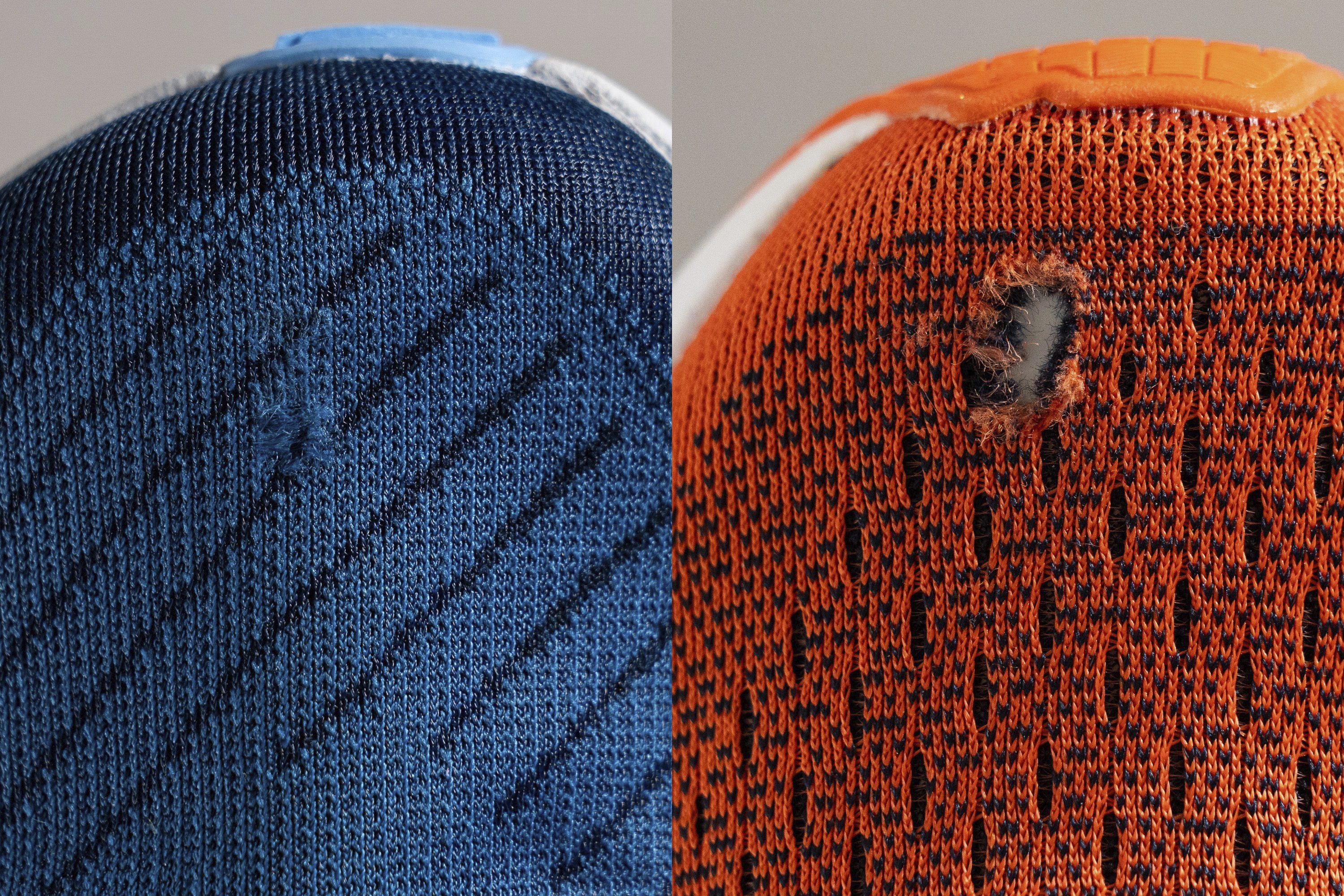
Runners who care about the durability of the toebox are usually runners whose big toe points up and sometimes pokes a hole through the upper, or runners who face some obstacles along the way and want their toebox to remain whole as long as possible.
We do the same test and assessment with the heel padding and assign it a durability score of 1-5.
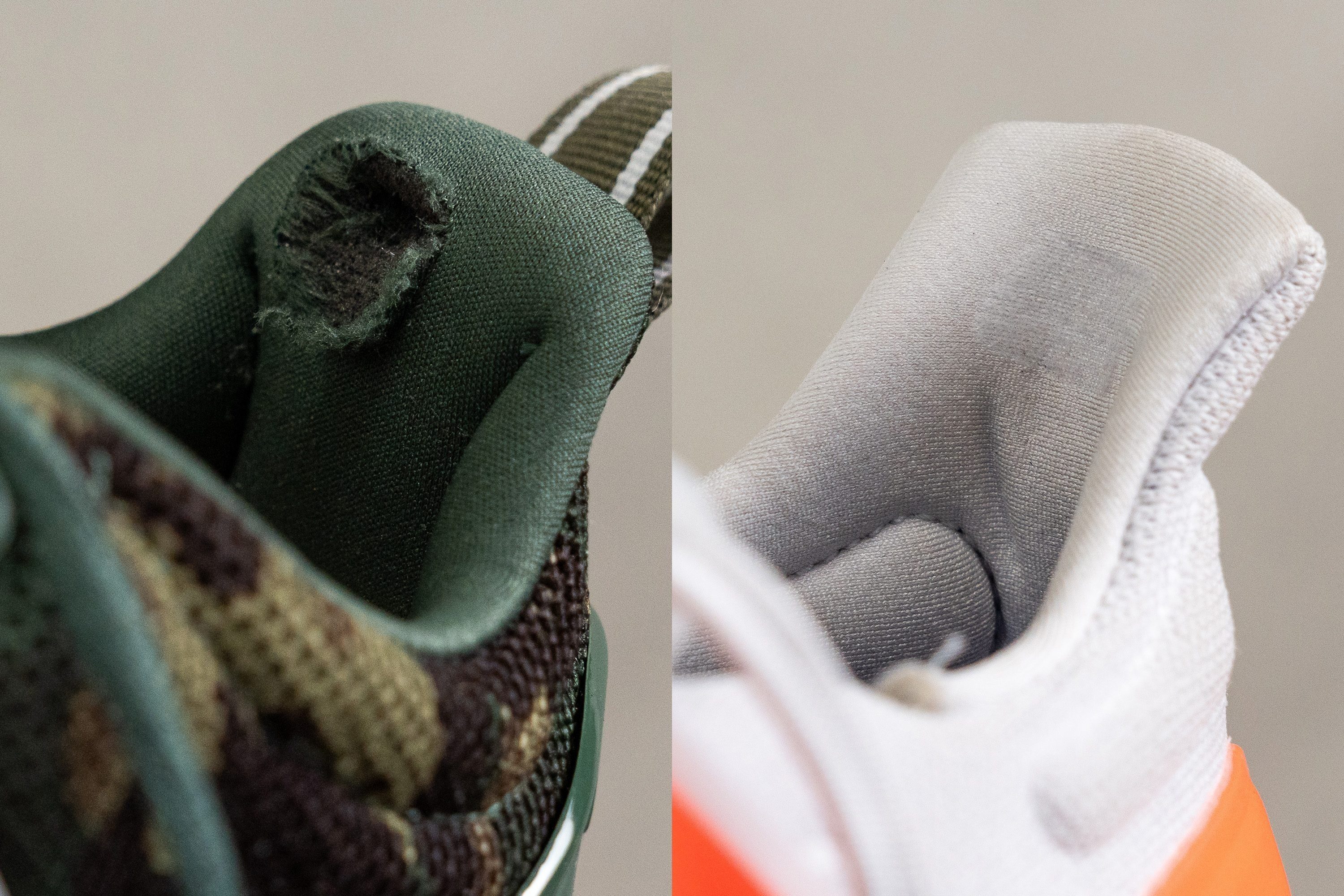
The durability of this part depends on the material used but also on how you put the shoe on, whether there’s some heel slipping, etc. There are dozens of running shoes for shin splints on our website that have very durable heel areas (scored 5/5 on our tests).
However, when it comes to the durability of the outsole, we don’t have to assess things.
Given the hardness of the outsole, we can accurately measure the depth of the dent.
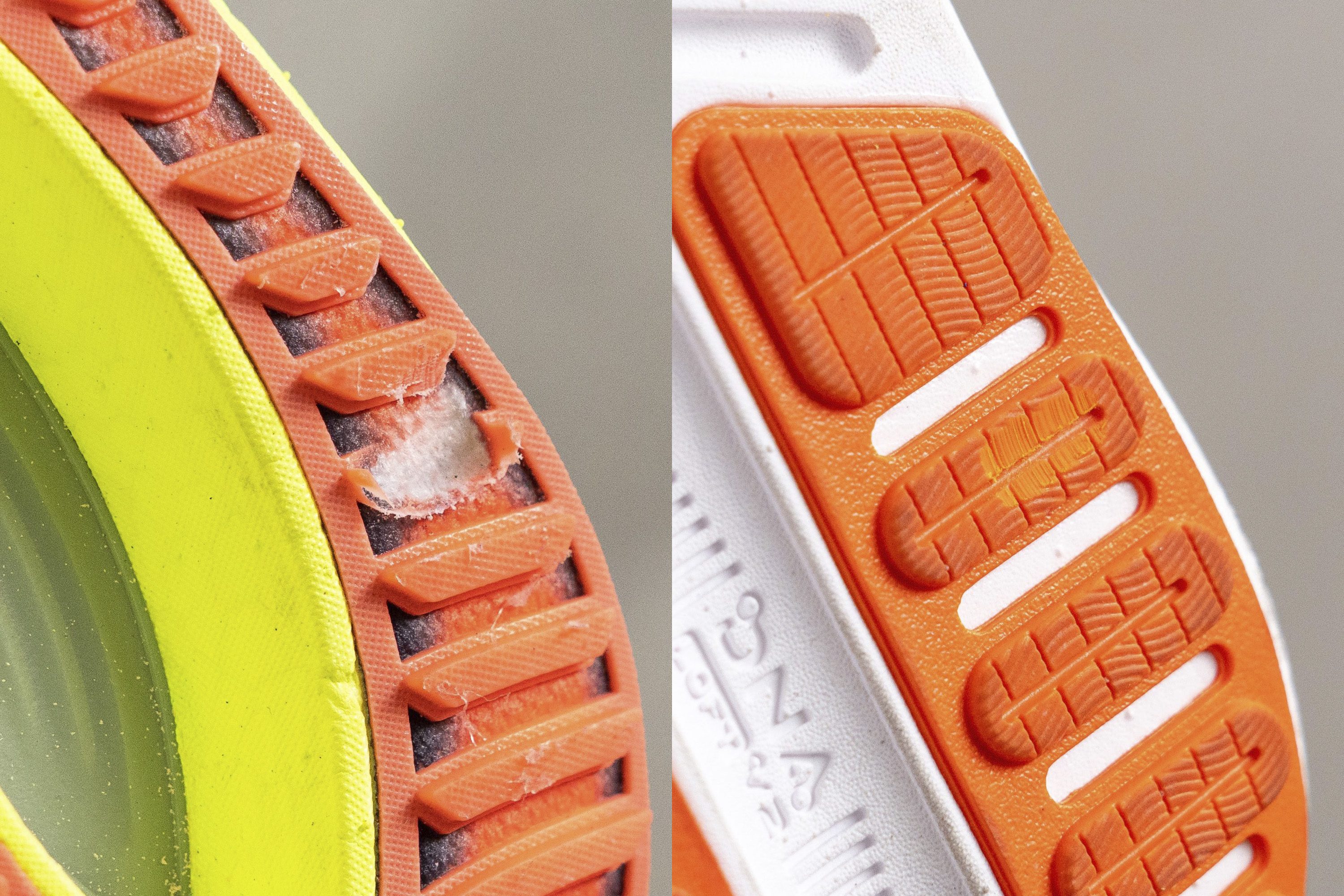
Arch support in running shoes for shin splints
We haven’t discussed this at the very beginning because if you got injured running, you most likely know whether you need stability running shoes (if you’re overpronating) or neutral running shoes (if you’re a supinator or have medium arches).
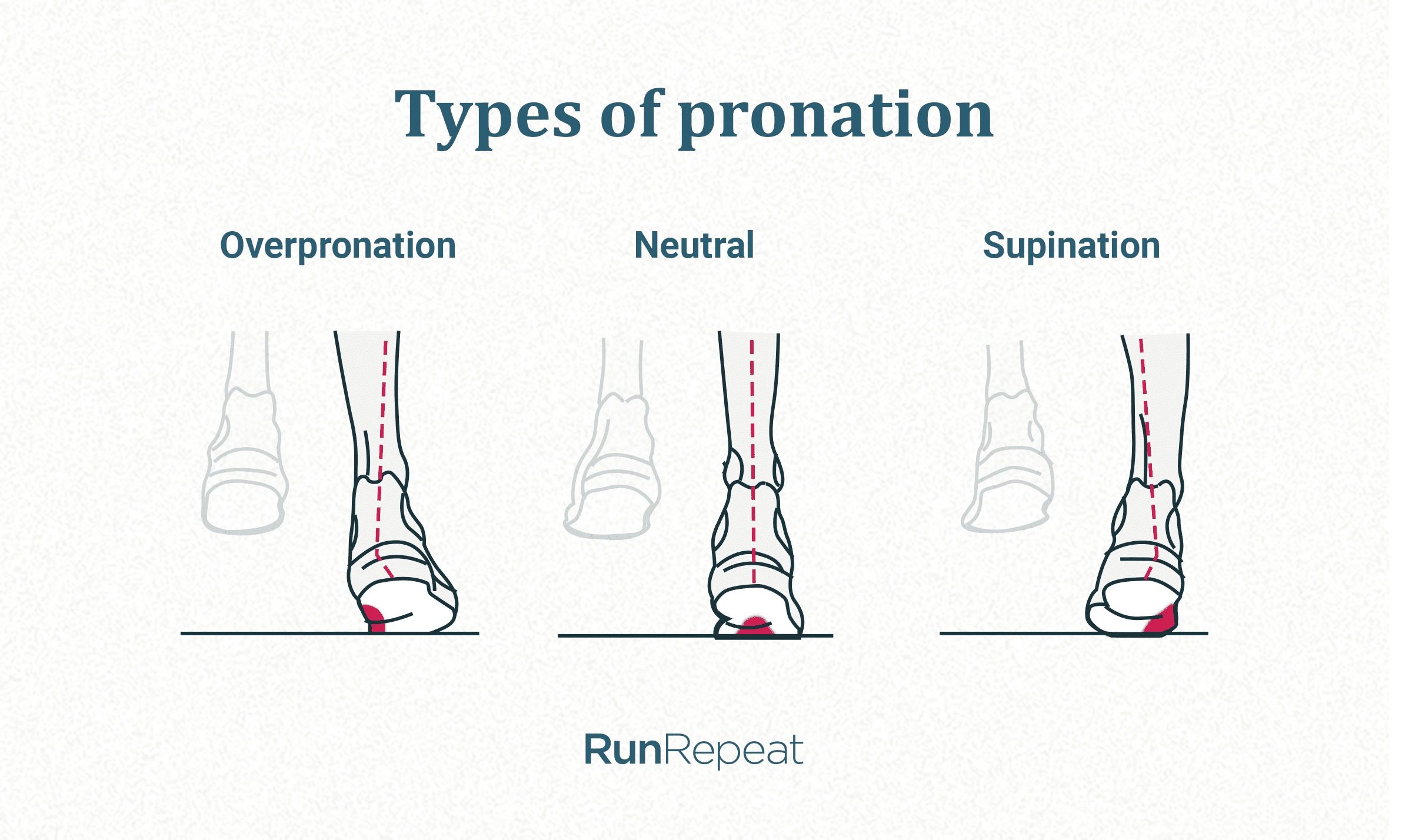
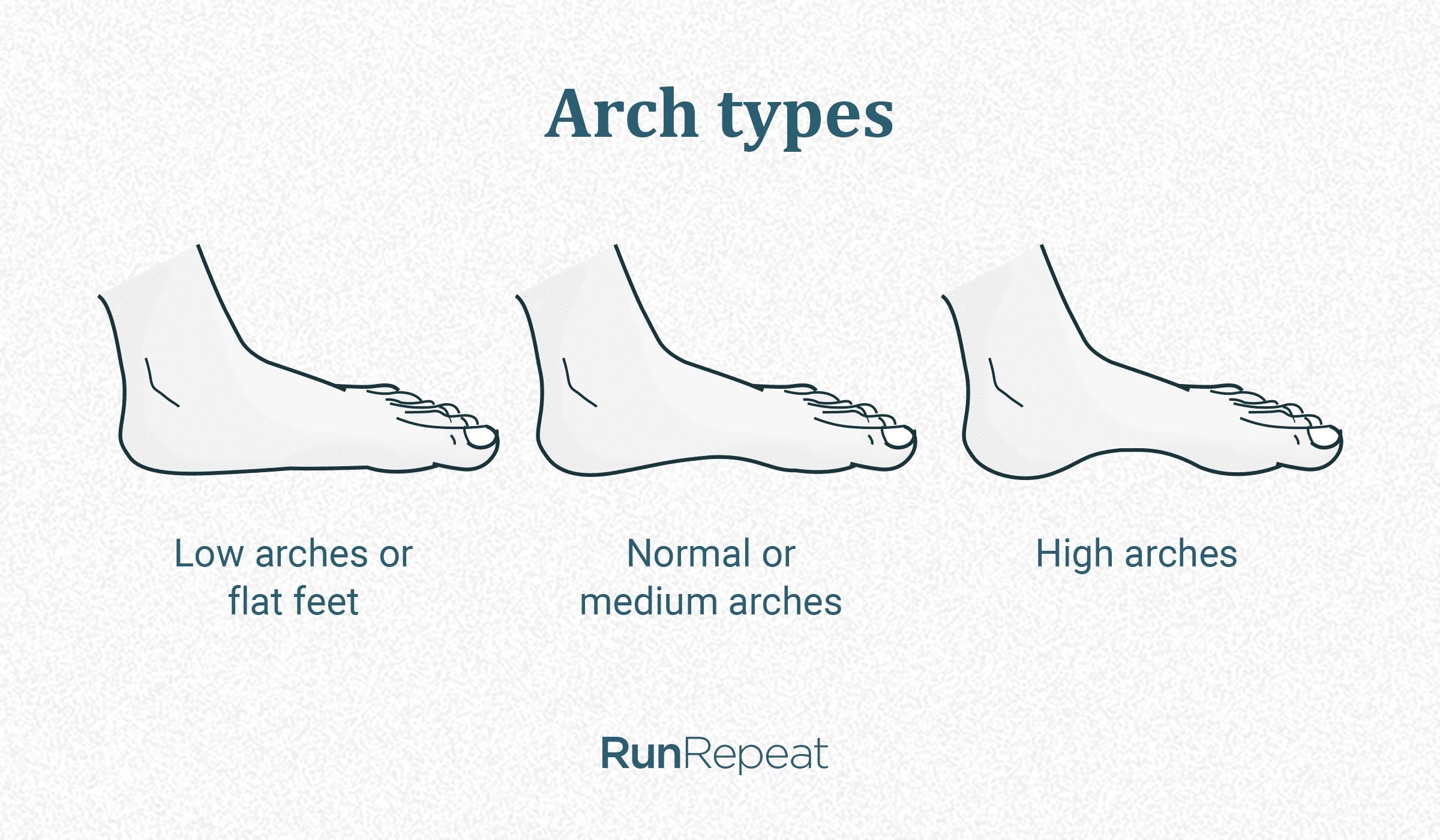
Just because it was not mentioned at the beginning does not mean it does not matter. If you’re an overpronator, have flat feet, or simply enjoy the extra stability that comes from trademarked technologies or different design elements (like deep side walls, heel bevels, medial posts, etc), you can find stability running shoes for shin splints. These running shoes offer stabilisation and support so that the heel is locked in place and the ankle rolls inward less.
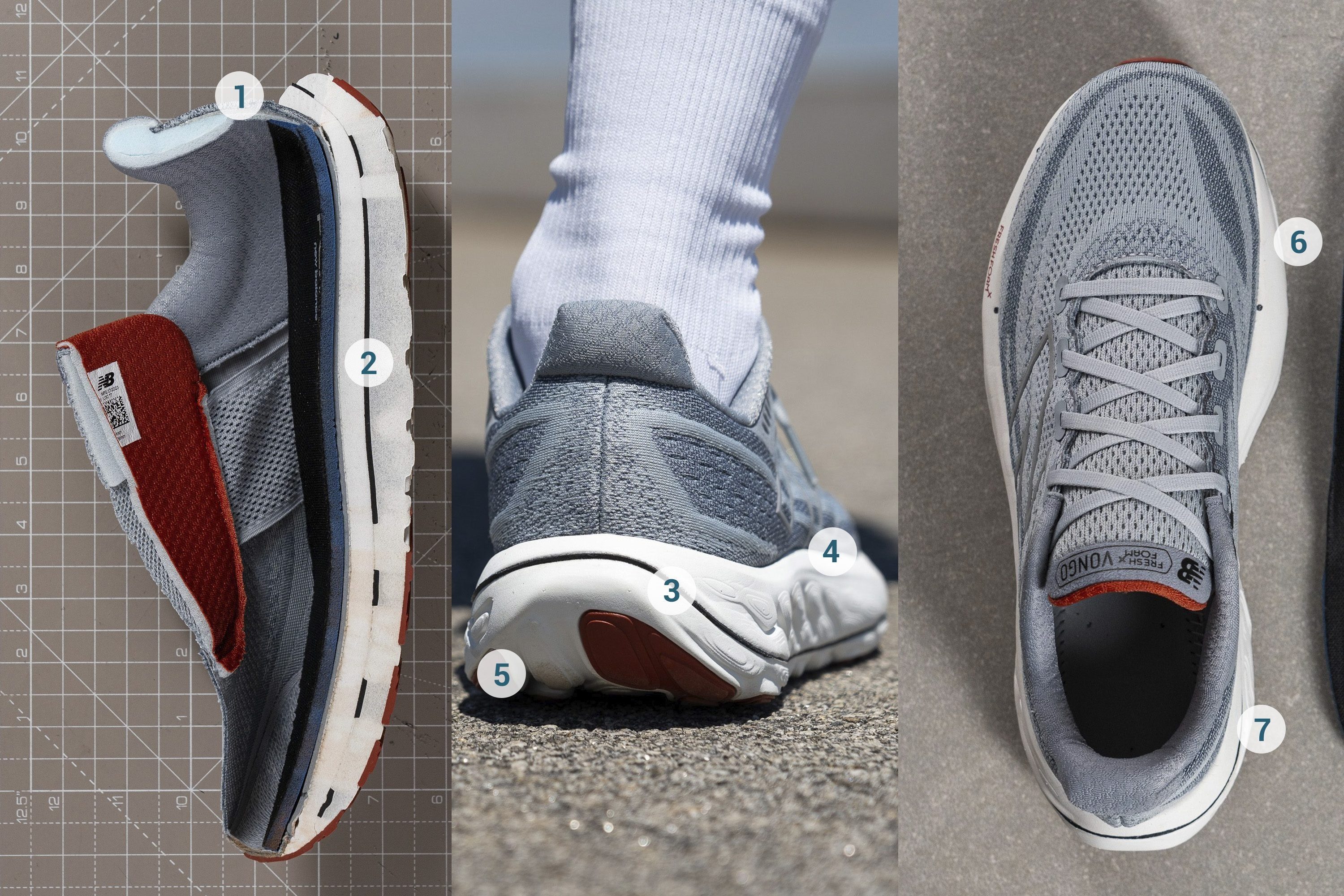
On the other hand, if you’re a neutral pronator or an underpronator, there are great shoe choices for your needs:
Wide toebox in running shoes for shin splints
Nailing the fit is always a priority when buying new running shoes, and this especially comes to light when you're dealing with an injury. You don't want anything else to annoy you or cause discomfort.
In our lab, we use a special gel that's poured into the shoes and frozen. This allows us to get accurate measurements of the shoe volume.
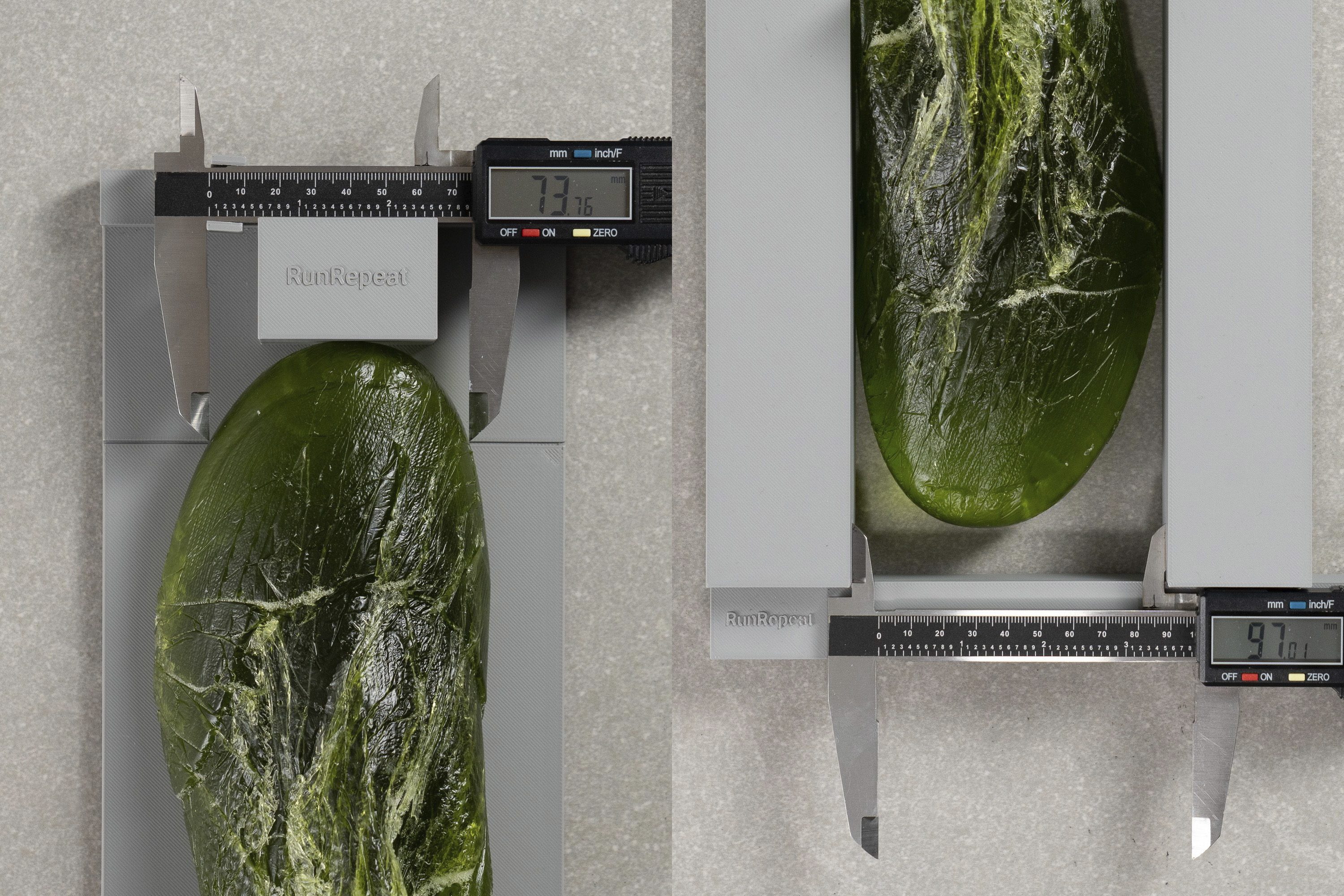
Thanks to this gel mould, we also measure the height of the toebox. This is very important for runners whose big toe points up and/or who regularly get black toenails.
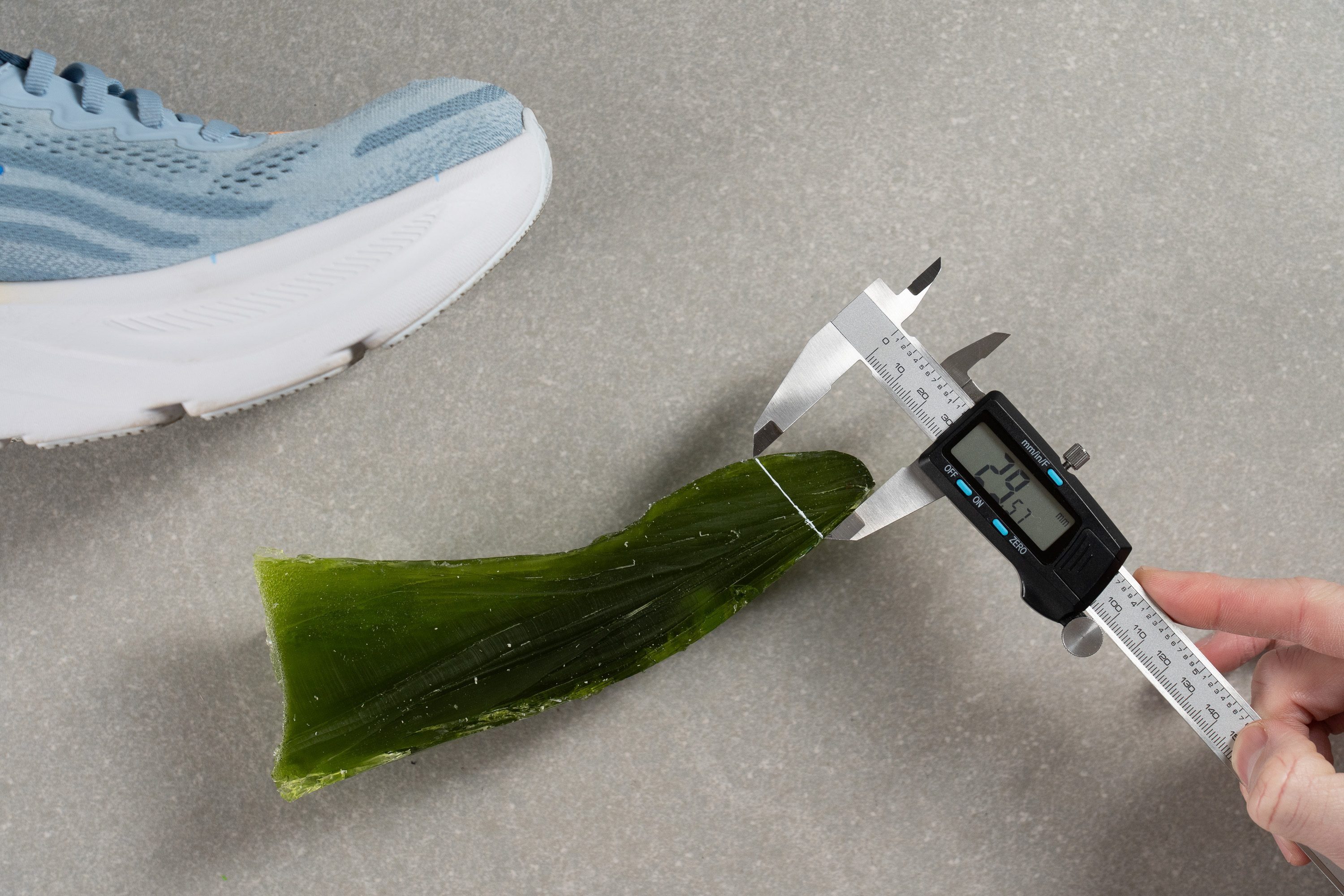
If you need the most room where the shoe is the widest, consider these running shoes:
In case you need room around the big toe, meaning you want toeboxes that are not (as) pointy, we sorted the running shoes by the widest toebox at the big toe here:
If you simply have very narrow feet and want a shoe that fits so that there's no sliding, this is the selection of the narrowest running shoes for shin splints:
And, if the upper in the toebox often puts pressure on your toes, meaning you need more vertical room, here's a selection of shoes for you:
Cheap running shoes for shinsplints
If having the latest model the moment it is released does not matter to you, we recommend looking for discounted running shoes or setting a price alert that will notify you once the price drops. You can do both on RunRepeat.
Some running shoes cost more when they are released - this is the so-called MSRP, the manufacturer's suggested retail price. They usually get cheaper over time, so here are running shoes for shin splints with the lowest MSRPs (with no discounts):
Shin splints rehab
The best way to start the rehabilitation process is to rest. Pain often goes away just by doing that. However, active recovery is recommended, as well as:
- gentle stretching
- non-weight-bearing exercises
- ice packs to reduce inflammation
- doing low-impact exercises like swimming or using a stationary bike or an elliptical trainer
- checking whether you’re running in proper running shoes.
Shin splints prevention
Given that shin splints happen in the lower leg extremities and as a result of overtraining, prevention focuses on:
- Strengthening and stretching calf and shin muscles
- Gradually building up the mileage and intensity, this progression should not have sudden spikes
- Doing cross-training, ideally low-intensity activities like swimming and cycling
- Making sure your shoes are not worn out; some foams are not as durable and might not offer enough impact protection after a certain mileage. Some data suggests changing shoes after 300 miles even if they look not damaged.
Sources
- https://www.researchgate.net/publication/381624332_Case_Report_Rehabilitation_and_Return_to_Running_Program_for_Shin_Splints_Runners
- https://www.researchgate.net/publication/379287153_Shin_Splint_The_Complexities_of_a_Common_lower_Leg_Affliction
- https://www.researchgate.net/publication/367265330_Shin_Splint_A_Review_Article
- https://www.tandfonline.com/doi/full/10.1080/17461391.2019.1603327?src=recsys
- RunRepeat lab data

